Botanical Gardens

The Botanical Gardens
History of the Botanical Gardens
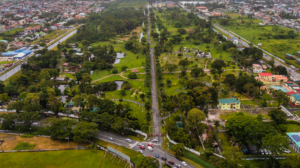 The Botanical Gardens is located in Georgetown, Region 4, with its main entrance found on Vlissengen Road, east of Bourda. It was once a sugar plantation – Planation Vlissengen; long abandoned, when the Royal Agriculture Society wrote to the Court of Policy for the establishment of a Botanical and Horticultural Garden to be established in Georgetown. In response to this request, the Botanical Gardens was established in 1877 on 78 hectares of land extending from Vlissengen Road and over Sheriff Street to the Sophia Plantation The gardens were originally established to support colonial agriculture and was dedicated to the study of natural flora as well as the introduction of economic and oriental plants from other tropical countries. The development of the Botanical Gardens began in 1878 under the guidance of Trinidadian Botanist Mr. H. Prestoe and Mr. John Fredrick Waby, who used his expertise as a gardener to develop the landscape. 1879 saw the arrival of Mr. George Samuel Jenman who would begin the infrastructural works to develop the land. By 1901, Mr. Jenman had traveled throughout Guyana, collecting and labeling over 8,000 species of plants. The property was transformed as additional lakes were dug to secure earth for roadway development, flowerpots and beds. Pipelines for irrigation, a pump and water tank were also installed to facilitate water movement. In the 1880s features such as the “kissing bridges” and benabs were installed. The gardens reached their peak of popularity during the 1940s and ‘50s. It was at this time that the Sugar Experimental Station and Rice Research Station were active in testing varieties and introducing new strains of these plants to the country. The palm-lined roadways, flowering plants and canals of water lilies were well-maintained at this time. Mr. Jenman served as the first Superintendent of the Botanical Gardens, a position he retained for 23 years until his death in 1902.
The Botanical Gardens is located in Georgetown, Region 4, with its main entrance found on Vlissengen Road, east of Bourda. It was once a sugar plantation – Planation Vlissengen; long abandoned, when the Royal Agriculture Society wrote to the Court of Policy for the establishment of a Botanical and Horticultural Garden to be established in Georgetown. In response to this request, the Botanical Gardens was established in 1877 on 78 hectares of land extending from Vlissengen Road and over Sheriff Street to the Sophia Plantation The gardens were originally established to support colonial agriculture and was dedicated to the study of natural flora as well as the introduction of economic and oriental plants from other tropical countries. The development of the Botanical Gardens began in 1878 under the guidance of Trinidadian Botanist Mr. H. Prestoe and Mr. John Fredrick Waby, who used his expertise as a gardener to develop the landscape. 1879 saw the arrival of Mr. George Samuel Jenman who would begin the infrastructural works to develop the land. By 1901, Mr. Jenman had traveled throughout Guyana, collecting and labeling over 8,000 species of plants. The property was transformed as additional lakes were dug to secure earth for roadway development, flowerpots and beds. Pipelines for irrigation, a pump and water tank were also installed to facilitate water movement. In the 1880s features such as the “kissing bridges” and benabs were installed. The gardens reached their peak of popularity during the 1940s and ‘50s. It was at this time that the Sugar Experimental Station and Rice Research Station were active in testing varieties and introducing new strains of these plants to the country. The palm-lined roadways, flowering plants and canals of water lilies were well-maintained at this time. Mr. Jenman served as the first Superintendent of the Botanical Gardens, a position he retained for 23 years until his death in 1902.
“An Urban Green Space that Connects People with Nature”
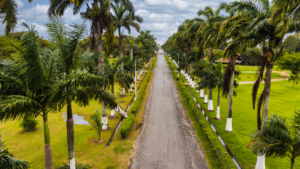 The Botanical Gardens is a place of diversity that brings nature and people together. In addition to its vast botanical and biodiversity contribution to Guyana, the Botanical Gardens is a time capsule of colonial and post-colonial heritage with a number of historical monuments being scattered throughout the grounds. The Bandstand, Jenman House Cottage and the two Kissing Bridges were all constructed between 1882 and 1885, a record of colonial architecture. Over the years, other monumental features were added to the Botanical Gardens’ landscape. This includes the Seven Ponds, the Mausoleum, the Victoria Lily Pond, the Pineapple Fountain and the Floral Falls. The boundaries of the Botanical Gardens were reviewed in the 1950s and 60s. The new boundaries saw the Botanical Gardens inhabiting 35 hectares of land bound by Mandela Avenue, Vlissingen Road and the Lamaha Canal, and Sheriff Street. These are the boundaries that we know of today.
The Botanical Gardens is a place of diversity that brings nature and people together. In addition to its vast botanical and biodiversity contribution to Guyana, the Botanical Gardens is a time capsule of colonial and post-colonial heritage with a number of historical monuments being scattered throughout the grounds. The Bandstand, Jenman House Cottage and the two Kissing Bridges were all constructed between 1882 and 1885, a record of colonial architecture. Over the years, other monumental features were added to the Botanical Gardens’ landscape. This includes the Seven Ponds, the Mausoleum, the Victoria Lily Pond, the Pineapple Fountain and the Floral Falls. The boundaries of the Botanical Gardens were reviewed in the 1950s and 60s. The new boundaries saw the Botanical Gardens inhabiting 35 hectares of land bound by Mandela Avenue, Vlissingen Road and the Lamaha Canal, and Sheriff Street. These are the boundaries that we know of today.
The Kissing Bridges
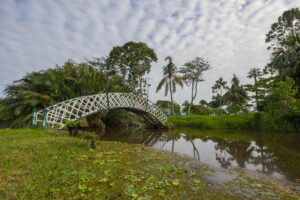 The Kissing Bridges are 2 iron bridges transported from England in 1884 and assembled sometime after their arrival in Guyana. Records indicate at least one of the bridges was installed and operation by January 1885. The curved wrought-iron structures were installed over the two main canals of the botanical gardens, allowing visitors to move with ease between the southern and northern islands of the landscape. The two ornate structures were dubbed the Kissing Bridges, although there are many fables as to why. One story says that they are called the “Kissing Bridges” because the bridges and their reflections resemble kissing lips. However, the most popular theory about the name of these bridges as the “Kissing Bridges” is because the bridges attract young lovers who share a romantic moment on the structures. Over the years this act has evolved into a popular wedding tradition where newly wedded couples share a kiss on the bridges after their vows. These recreational bridges have become engrained into our local Guyanese culture.
The Kissing Bridges are 2 iron bridges transported from England in 1884 and assembled sometime after their arrival in Guyana. Records indicate at least one of the bridges was installed and operation by January 1885. The curved wrought-iron structures were installed over the two main canals of the botanical gardens, allowing visitors to move with ease between the southern and northern islands of the landscape. The two ornate structures were dubbed the Kissing Bridges, although there are many fables as to why. One story says that they are called the “Kissing Bridges” because the bridges and their reflections resemble kissing lips. However, the most popular theory about the name of these bridges as the “Kissing Bridges” is because the bridges attract young lovers who share a romantic moment on the structures. Over the years this act has evolved into a popular wedding tradition where newly wedded couples share a kiss on the bridges after their vows. These recreational bridges have become engrained into our local Guyanese culture.
The Bandstand
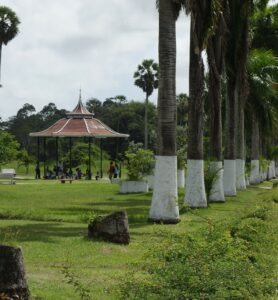 The Bandstand is located centrally in the western section of the Botanical Gardens and is easily accessible from the western entrance on Vlissingen Road. The structure was built around 1882 to commemorate the work of Mr. John Brummell. Brummell served as the Sheriff to Demerara and was a part of the first instalment of the Botanical Gardens’ Board of Directors. He passed away in 1881.The Bandstand in the Botanical Gardens is one of three around Georgetown and is considered to be the oldest of the three.
The Bandstand is located centrally in the western section of the Botanical Gardens and is easily accessible from the western entrance on Vlissingen Road. The structure was built around 1882 to commemorate the work of Mr. John Brummell. Brummell served as the Sheriff to Demerara and was a part of the first instalment of the Botanical Gardens’ Board of Directors. He passed away in 1881.The Bandstand in the Botanical Gardens is one of three around Georgetown and is considered to be the oldest of the three.
The Jenman House
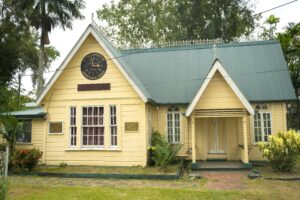 The Jenman House is a single-story timber building designed by Mr. John Brummell and built in 1881. It was originally used as the meeting venue for the Botanical Gardens’ Board of Directors. The Jenman House or Building has been known by many names over the years – the Curator’s Lodge and the Caretaker’s Hut – but in 2004 the building was officially designated as the Jenman’s Education Centre, after George Samuel Jenman. Most recently the building has served as the offices of the Protected Areas Trust Fund.
The Jenman House is a single-story timber building designed by Mr. John Brummell and built in 1881. It was originally used as the meeting venue for the Botanical Gardens’ Board of Directors. The Jenman House or Building has been known by many names over the years – the Curator’s Lodge and the Caretaker’s Hut – but in 2004 the building was officially designated as the Jenman’s Education Centre, after George Samuel Jenman. Most recently the building has served as the offices of the Protected Areas Trust Fund.
The Place of Guyana’s Heroes
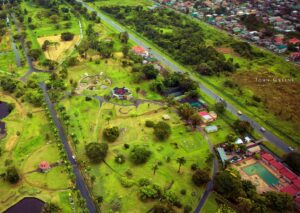 The 1969 Seven Pond or the Place of Heroes along with the Mausoleum, provide a public resting place for former heads of state and people of significant influence to Guyana in its early days of development. The Seven Ponds was designed by Guyanese architect Mr. George Henry and is located on the south of the central avenue in the Botanical Gardens. It is the final resting place of Sir David Rose – the first Guyanese Governor General, Martin Carter – celebrated Guyanese poet, Hugh Desmond Hoyte – former President of Guyana from 1986 to 1992, and Arthur Chung – Guyana’s first President from 1970-1980. The design of the Seven Ponds is of just that – seven ponds. It has a circular central pond with a sculpture in the middle and six segmented circular ponds distributed in a radial pattern around the central feature. The ponds design reflects the six peoples of Guyana working together, where the six ponds feed into the central seventh pond as a show of unity and coming together.
The 1969 Seven Pond or the Place of Heroes along with the Mausoleum, provide a public resting place for former heads of state and people of significant influence to Guyana in its early days of development. The Seven Ponds was designed by Guyanese architect Mr. George Henry and is located on the south of the central avenue in the Botanical Gardens. It is the final resting place of Sir David Rose – the first Guyanese Governor General, Martin Carter – celebrated Guyanese poet, Hugh Desmond Hoyte – former President of Guyana from 1986 to 1992, and Arthur Chung – Guyana’s first President from 1970-1980. The design of the Seven Ponds is of just that – seven ponds. It has a circular central pond with a sculpture in the middle and six segmented circular ponds distributed in a radial pattern around the central feature. The ponds design reflects the six peoples of Guyana working together, where the six ponds feed into the central seventh pond as a show of unity and coming together.
The Mausoleum
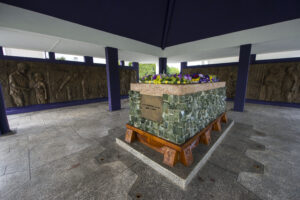 The Mausoleum is a burial and commemorative monument build in 1986 as the final resting place of President Linden Forbes Sampson Burnham. Burnham’s Mausoleum is located next to the place of the Seven Ponds. The Mausoleum was designed by Guyanese architect George Henry and construction on the structure was completed in 1986. The mausoleum was built mainly of reinforced concrete and local materials to reflect integral moments in Burnham’s life. The floor of the structure is granite sourced from the Upper Essequibo and Mazaruni districts. The tomb itself sits in the center of the structure on top of a specially crafted base. This base was crafted from greenheart and the four sides of the tomb itself are decorated with glass briquetted manufactured by the local Glass Factory. The western face of the tomb carries the motif of the Presidential Standard used by former president Burnham. The walls of the mausoleum to the southern and western sides carry two large bronze panels designed by Mr., Ivor Thom, a popular local sculpture. The design illustrated aspects and achievements of Burnham’s life and political career. The mausoleum was designed to take the shape of a crucifix when viewed from above. Forbes Burnham was born on February 20, 1923 and served as Prime Minister of Guyana from 1964 until he became the first Executive President of Guyana in 1980; an office he held until his death on August 6, 1985.
The Mausoleum is a burial and commemorative monument build in 1986 as the final resting place of President Linden Forbes Sampson Burnham. Burnham’s Mausoleum is located next to the place of the Seven Ponds. The Mausoleum was designed by Guyanese architect George Henry and construction on the structure was completed in 1986. The mausoleum was built mainly of reinforced concrete and local materials to reflect integral moments in Burnham’s life. The floor of the structure is granite sourced from the Upper Essequibo and Mazaruni districts. The tomb itself sits in the center of the structure on top of a specially crafted base. This base was crafted from greenheart and the four sides of the tomb itself are decorated with glass briquetted manufactured by the local Glass Factory. The western face of the tomb carries the motif of the Presidential Standard used by former president Burnham. The walls of the mausoleum to the southern and western sides carry two large bronze panels designed by Mr., Ivor Thom, a popular local sculpture. The design illustrated aspects and achievements of Burnham’s life and political career. The mausoleum was designed to take the shape of a crucifix when viewed from above. Forbes Burnham was born on February 20, 1923 and served as Prime Minister of Guyana from 1964 until he became the first Executive President of Guyana in 1980; an office he held until his death on August 6, 1985.
The Victoria Lily Pond
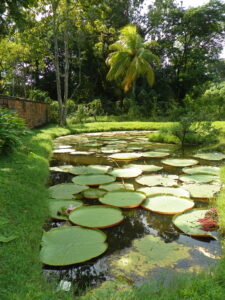 The Victoria Lily Pond is a simple pond feature in the south-western side of the Botanical Gardens, just off of the first pathway into the Gardens. The pond houses two species of lilies including the Guyana’s national flower, the Victoria Regia lily. The Victoria Regia or Victoria amazonia is the largest water lily in the world. It is featured on Guyana’s Coat-of-Arms. The Victoria amazonica is also called the Victoria Lily, the Amazon Water Lily, and the Giant Water Lily. The Giant Lily coexists with the Nymphaea Purple Joy tropical water lily, a beautiful purple water lily with a breathtaking perfume smell, rumored to be used as just perfume in the ancient Egyptian aristocratic society.
The Victoria Lily Pond is a simple pond feature in the south-western side of the Botanical Gardens, just off of the first pathway into the Gardens. The pond houses two species of lilies including the Guyana’s national flower, the Victoria Regia lily. The Victoria Regia or Victoria amazonia is the largest water lily in the world. It is featured on Guyana’s Coat-of-Arms. The Victoria amazonica is also called the Victoria Lily, the Amazon Water Lily, and the Giant Water Lily. The Giant Lily coexists with the Nymphaea Purple Joy tropical water lily, a beautiful purple water lily with a breathtaking perfume smell, rumored to be used as just perfume in the ancient Egyptian aristocratic society.
The Pineapple Fountain
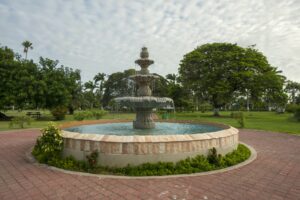
The Pineapple Fountain was a water feature added to the Botanical Gardens’ landscape in 2015 as part of the Three Parks Initiative. The Fountain was installed as a rehabilitation project of an old fountain that existed around the same area. The new fountain is a three-layer marble structure topped by a pineapple – hence the name. It was donated by the Chinese Government through New Thriving Estb. The Pineapple Fountain sits just opposite the Bandstand and provides a poetesque location for special moments like weddings.
The Floral Falls
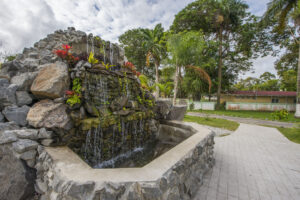 The Floral Falls was the last water feature to be added to the Botanical Gardens under the Three Parks Initiative in 2015. It is a grand waterfall feature that replicates the conditions needed for succulents and bromeliads that grow around grander waterfalls like at the Kaieteur waterfall. The area around the falls is used as an education and information feature, with informative signs about waterfall ecosystems and biodiversity. It has become an ideal spot for photoshoots and is now part of the wedding photoshoot tour around the Botanical Gardens, which includes the Pineapple Fountain and the Kissing Bridges.
The Floral Falls was the last water feature to be added to the Botanical Gardens under the Three Parks Initiative in 2015. It is a grand waterfall feature that replicates the conditions needed for succulents and bromeliads that grow around grander waterfalls like at the Kaieteur waterfall. The area around the falls is used as an education and information feature, with informative signs about waterfall ecosystems and biodiversity. It has become an ideal spot for photoshoots and is now part of the wedding photoshoot tour around the Botanical Gardens, which includes the Pineapple Fountain and the Kissing Bridges.
Biodiversity Gardens
Those interested in a rainforest experience in the heart of Georgetown can visit the bird sanctuary on the eastern side of the Gardens, where over 200 species of birds are on display, as well as reptiles, amphibians, mammals, local tree species and plants from Brazil, Sri Lanka, India and Burma. The Botanical Gardens are now one of the last areas in central Georgetown where people can still truly experience and interact with nature. The Biodiversity Garden is a resource available to current and future generations to better understand and appreciate our natural heritage. The Biodiversity Gardens will function as a centre for discovery, research, learning and create s stronger foundation for a Low-Carbon Economy.

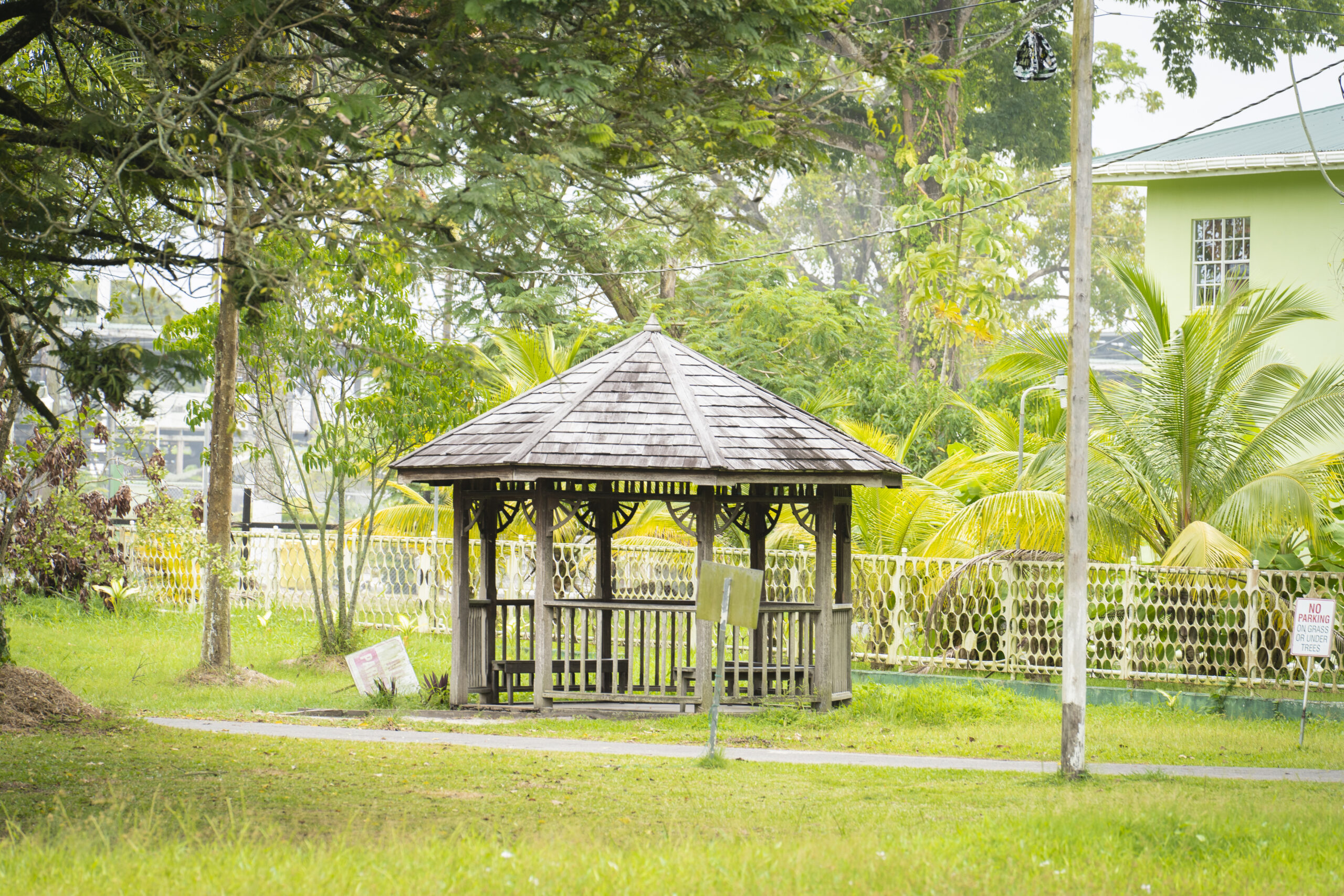
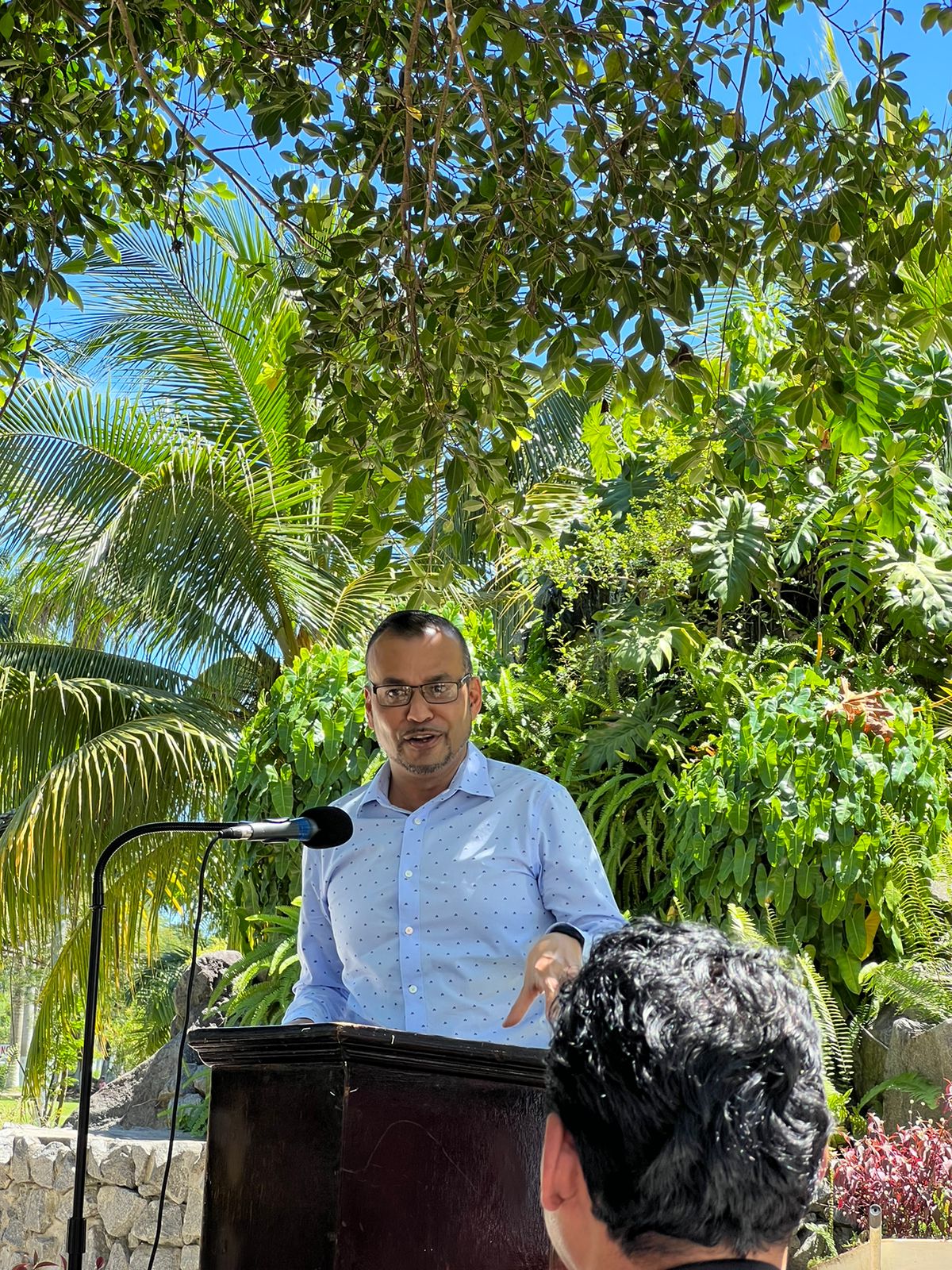
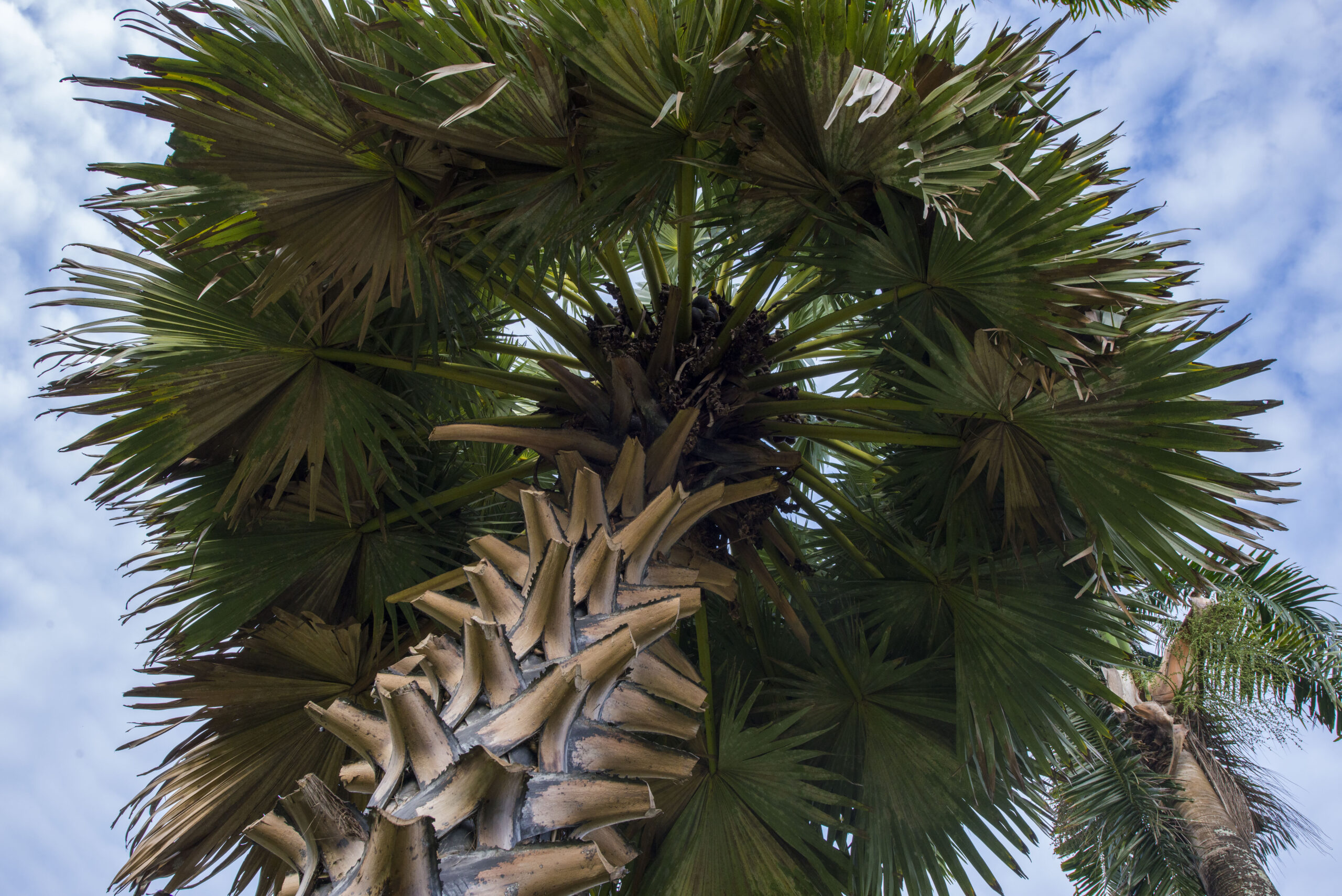
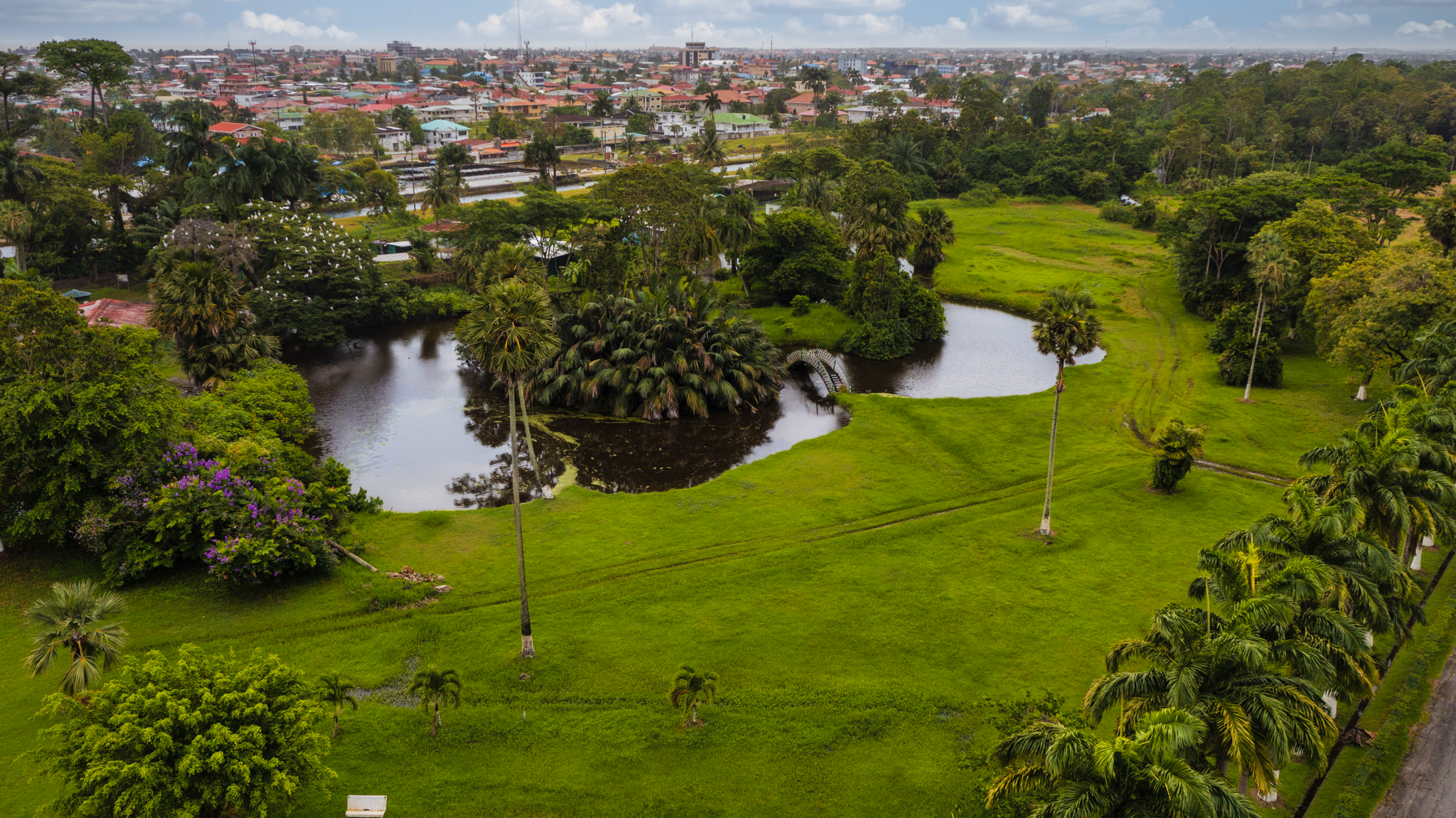
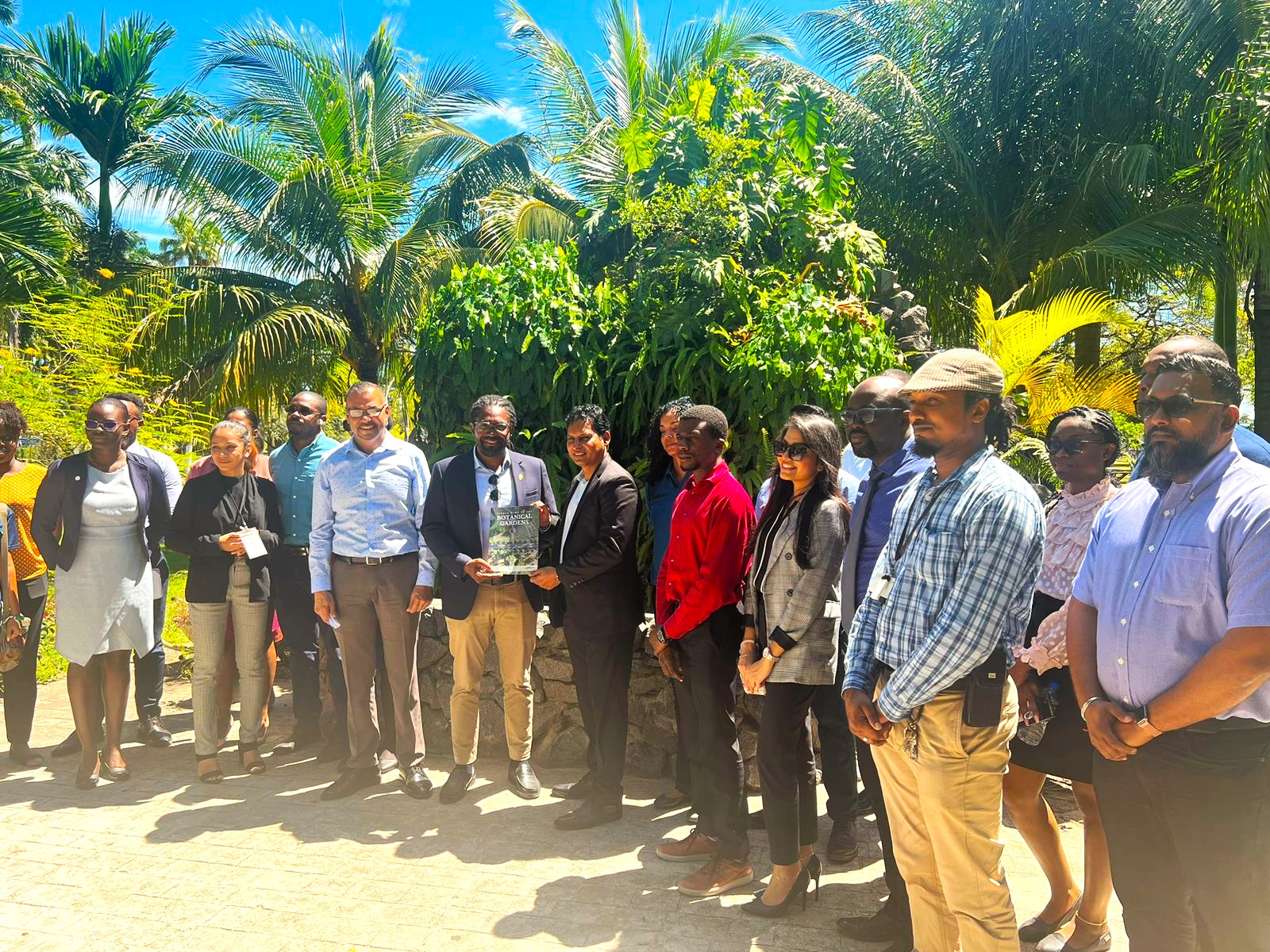
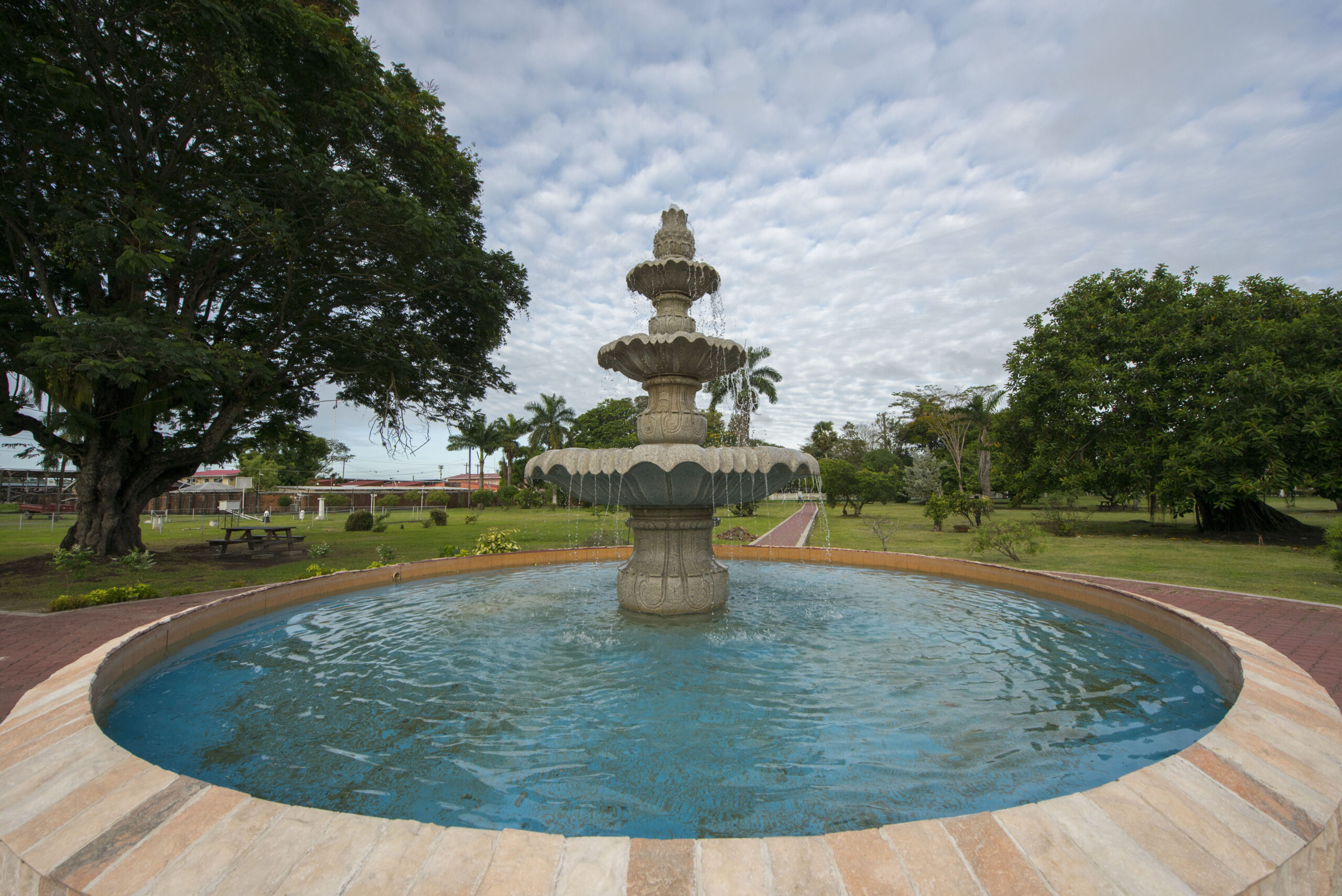
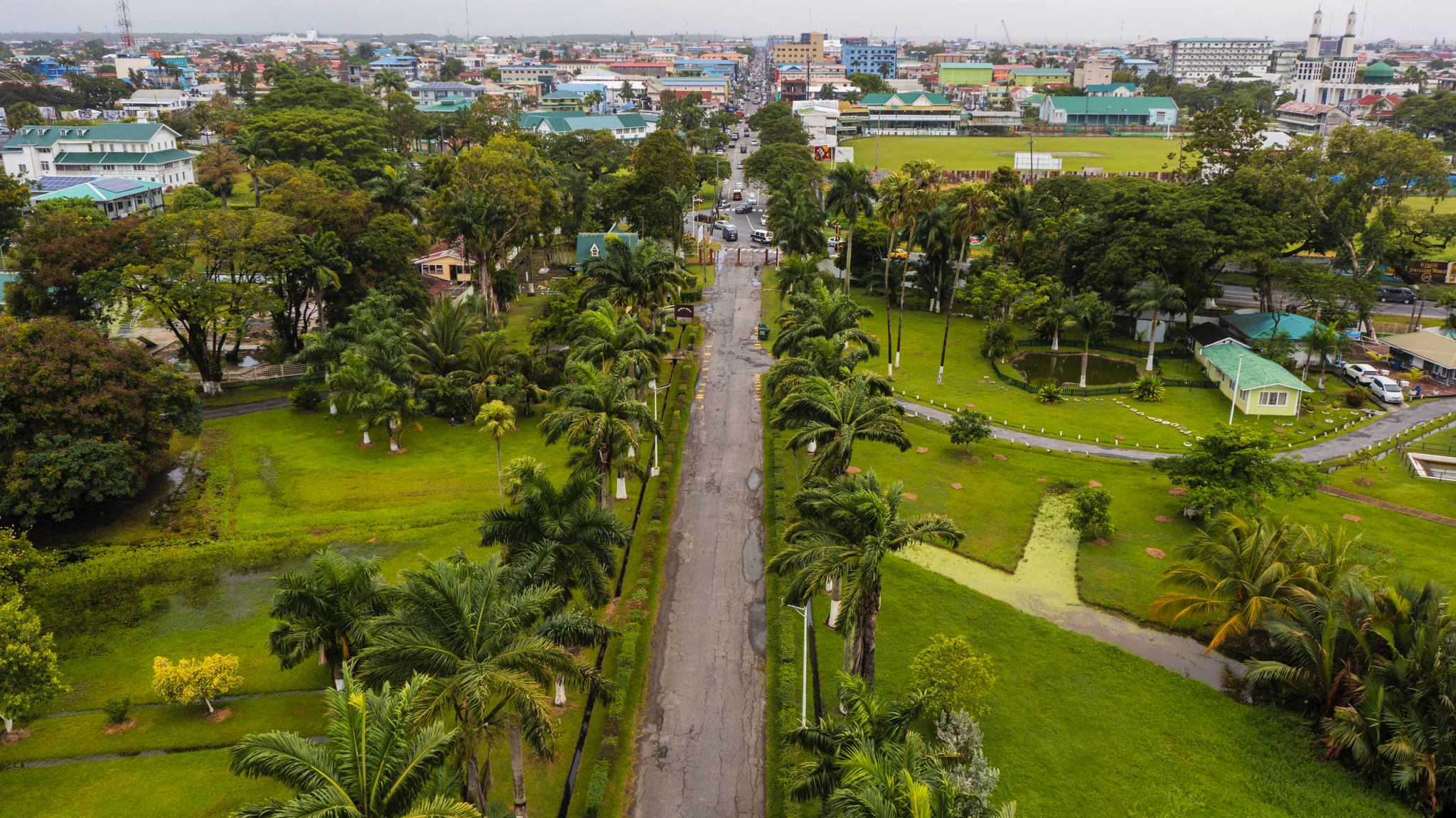
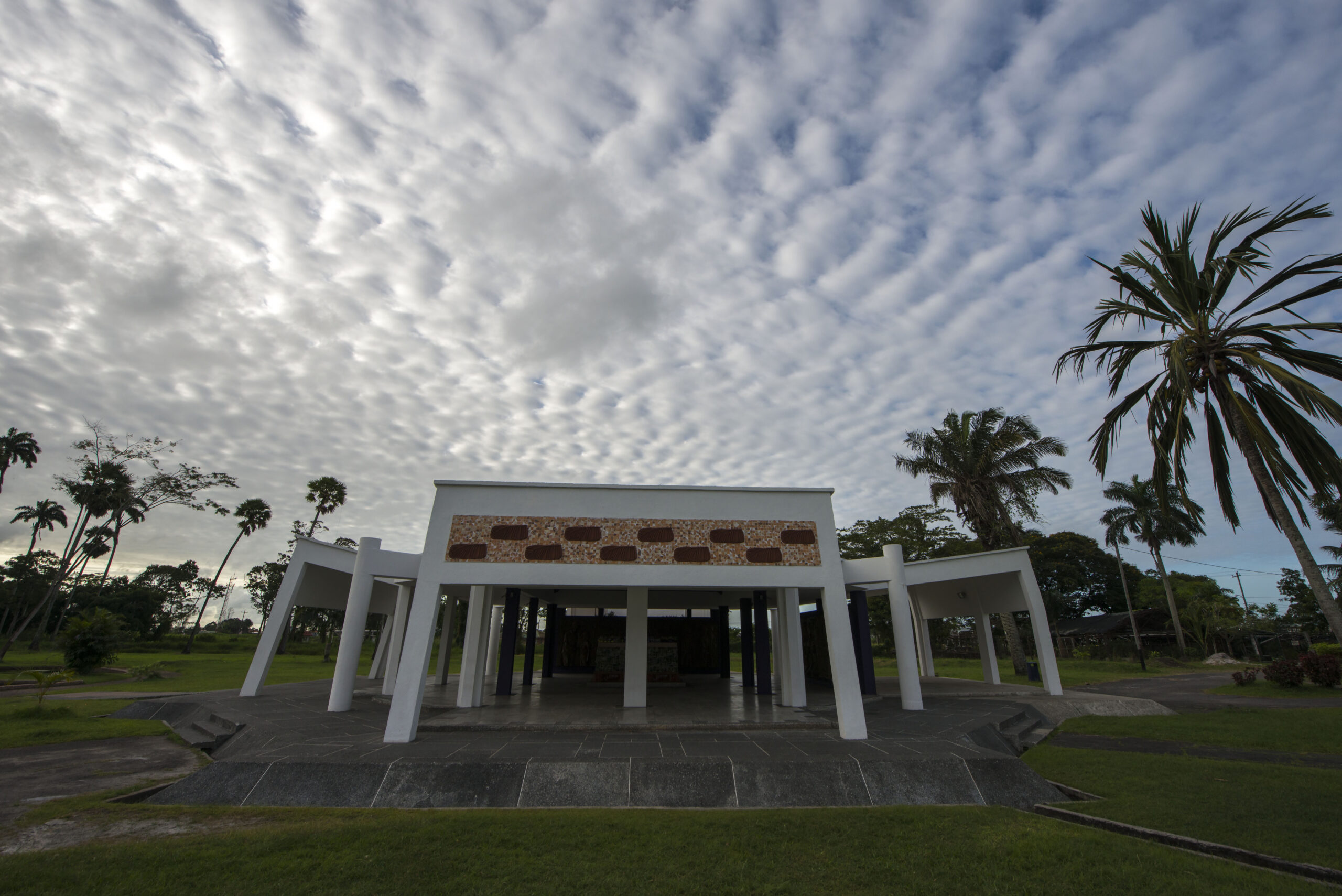
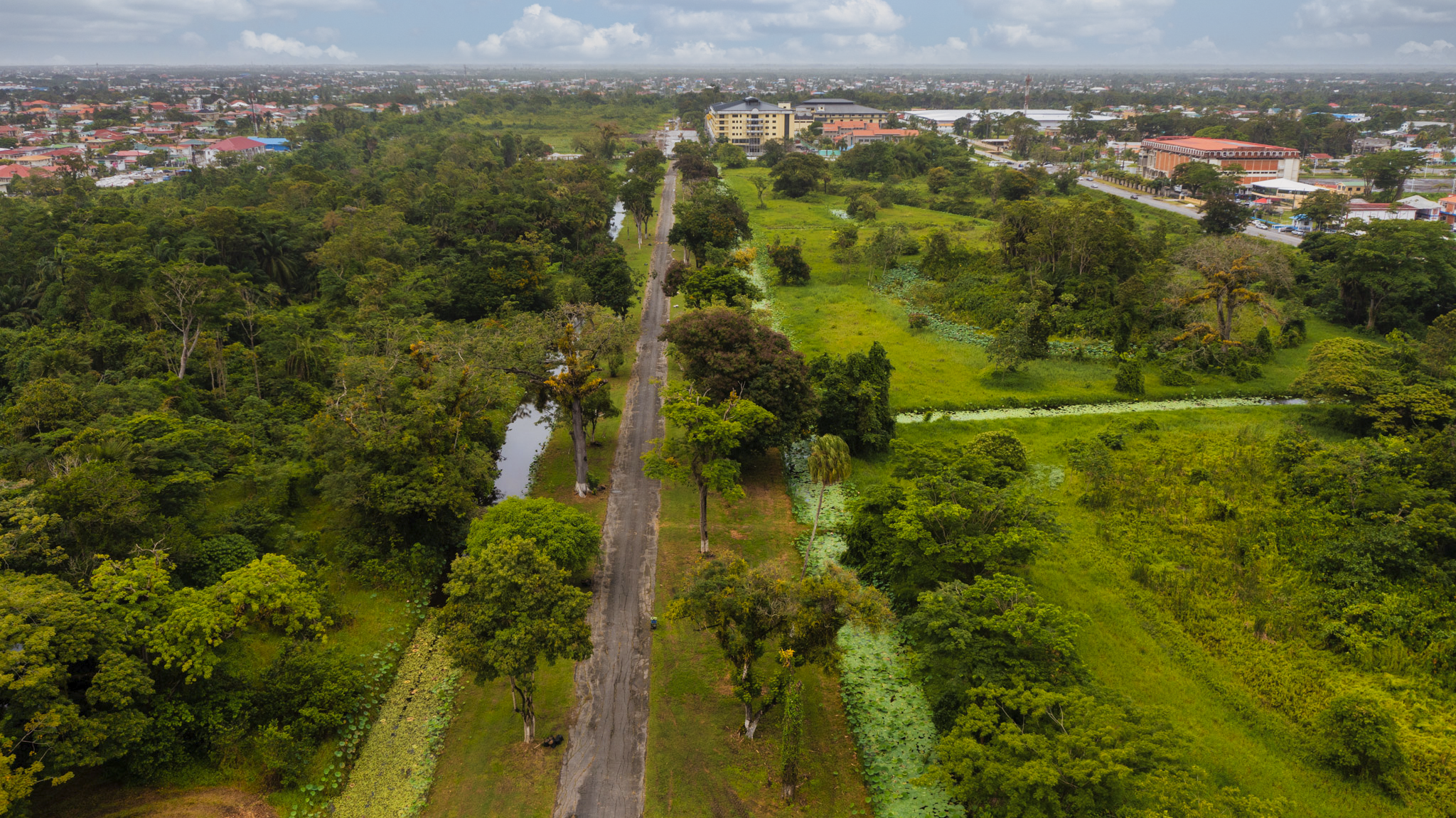
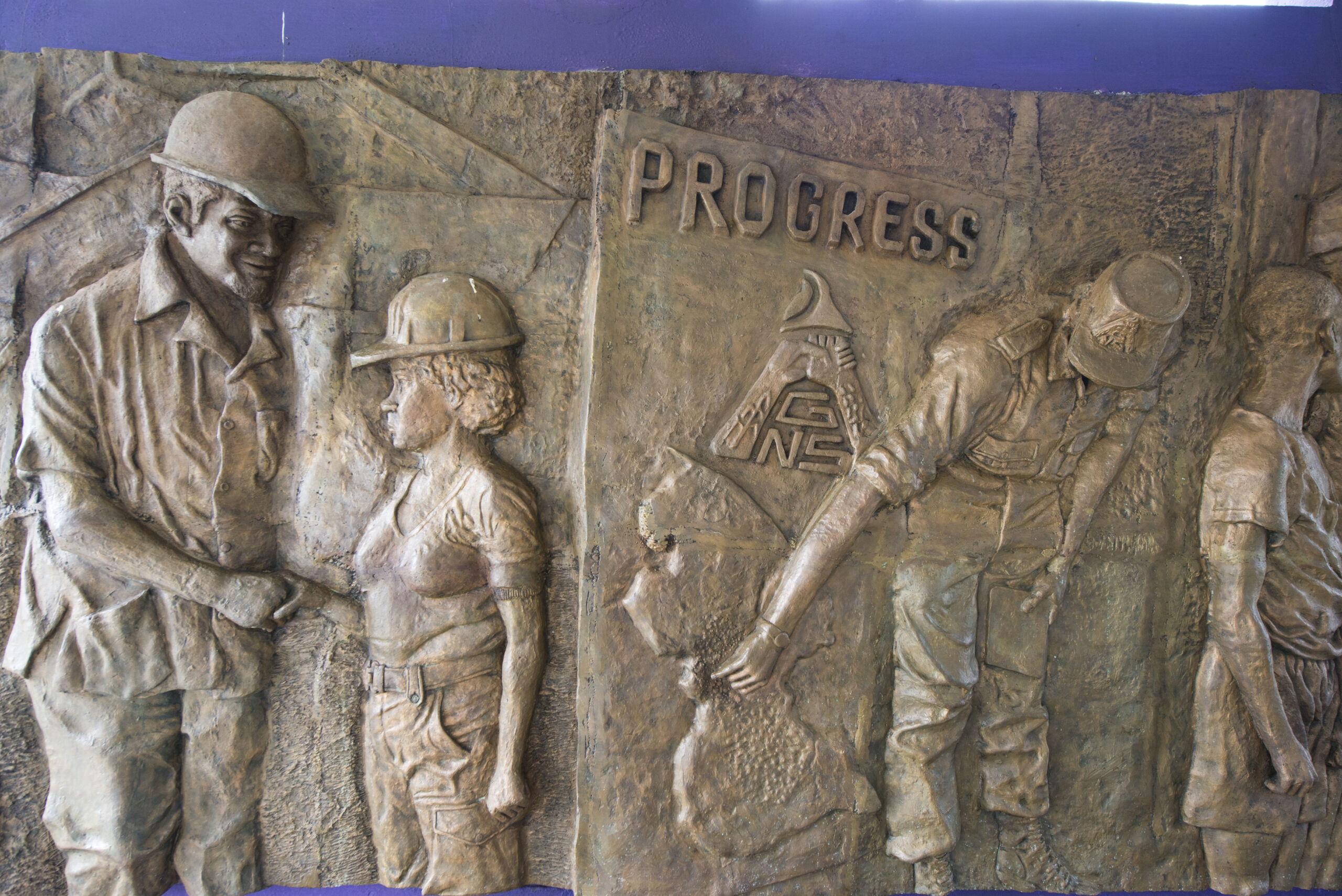
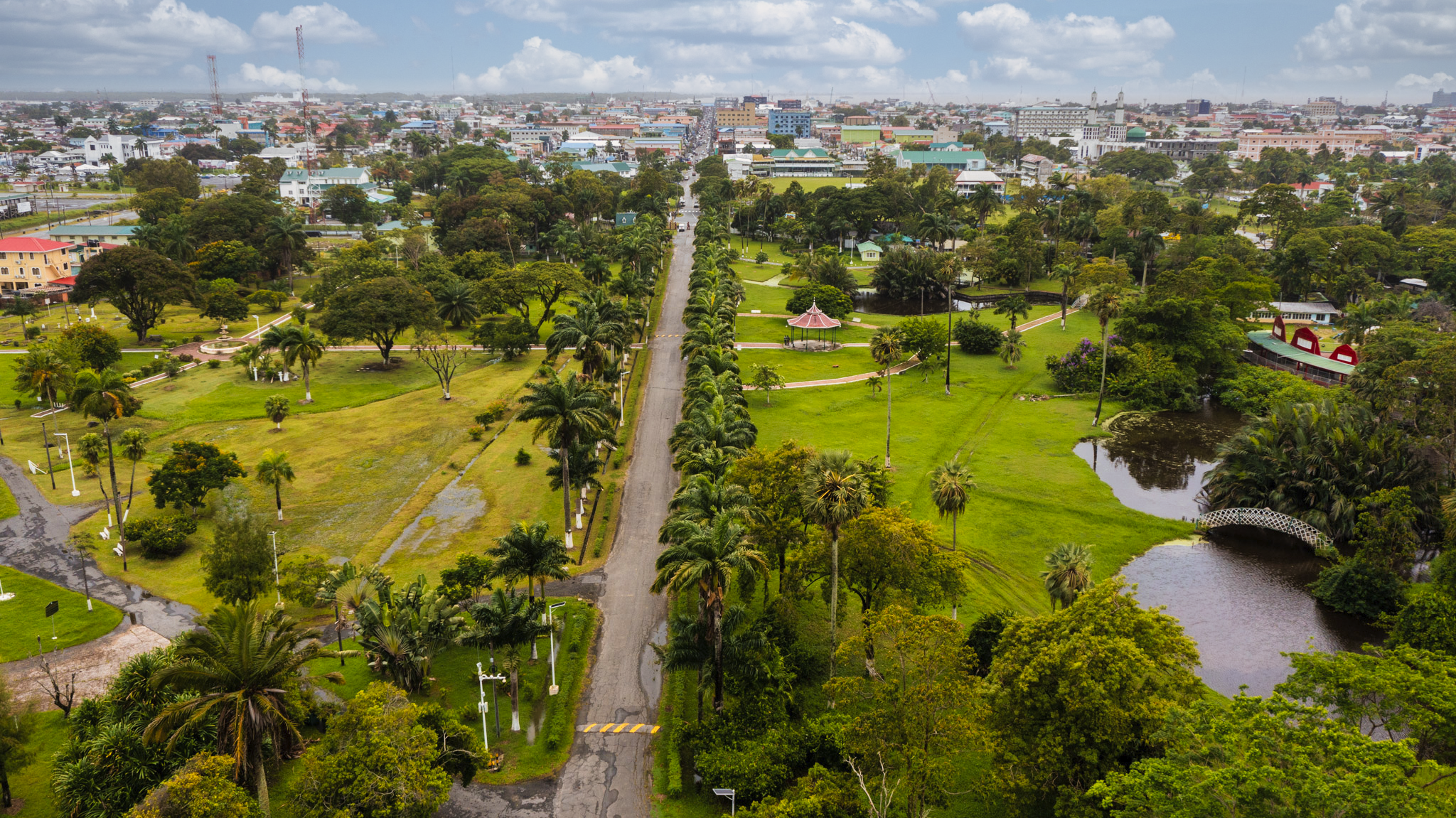
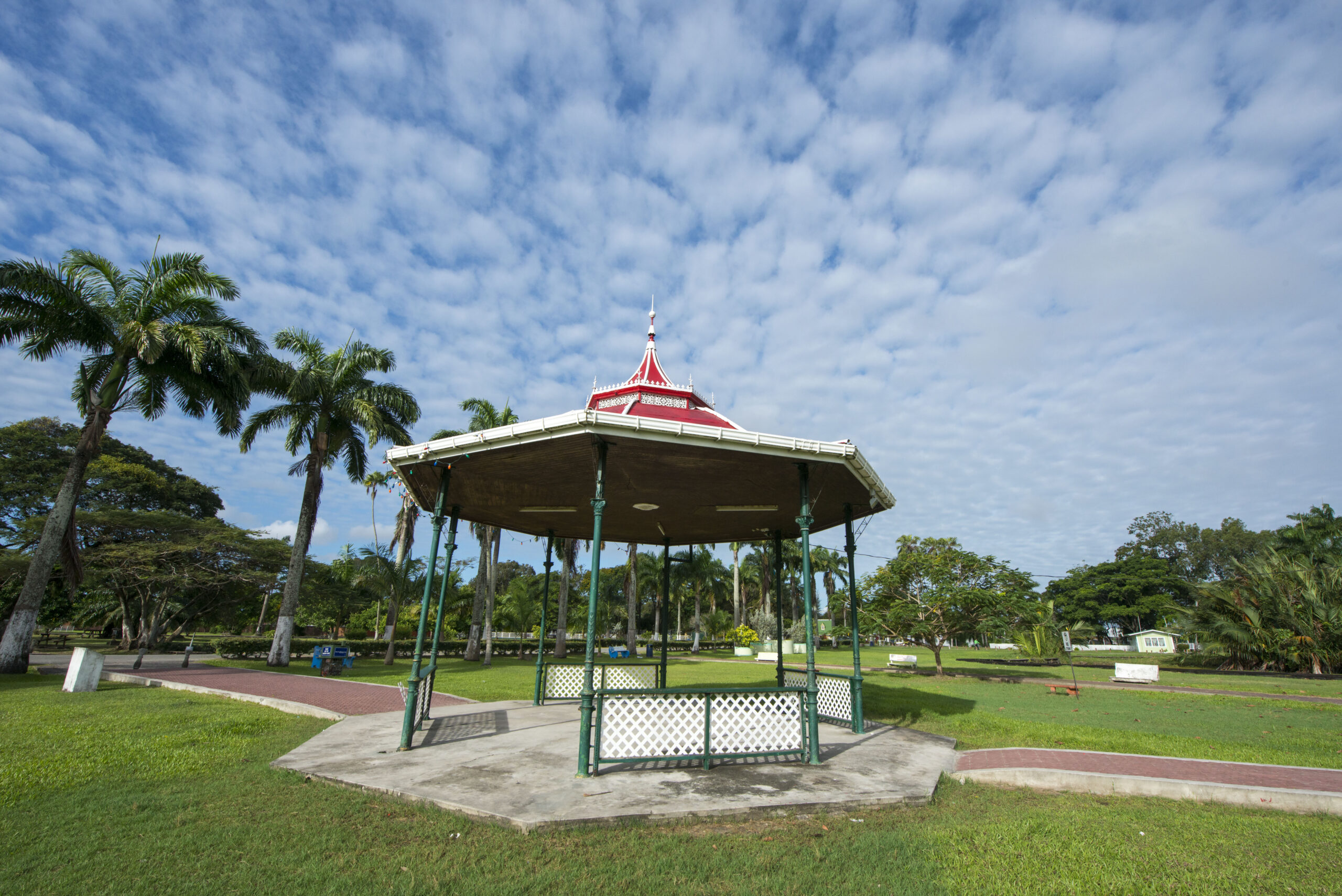
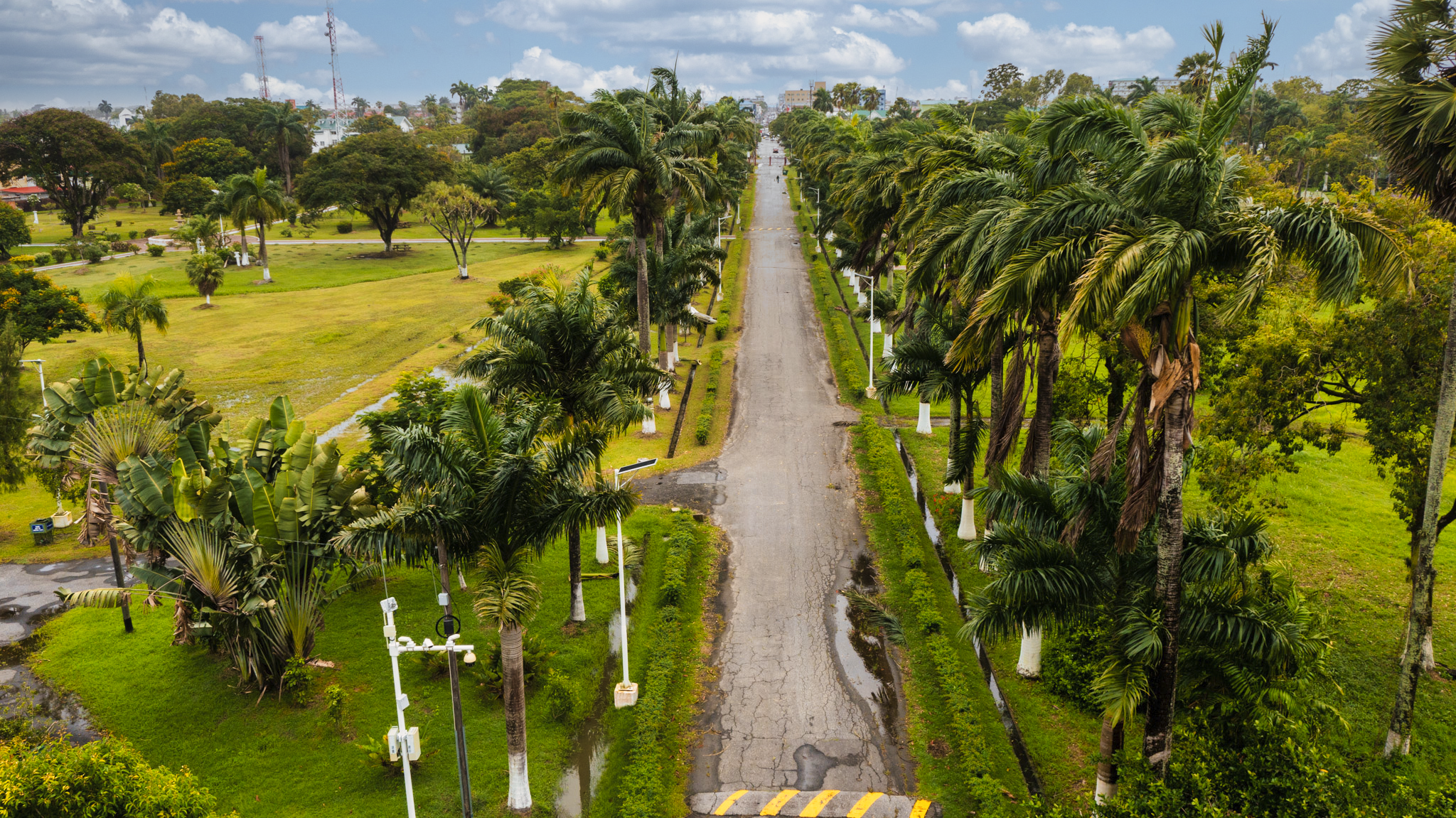
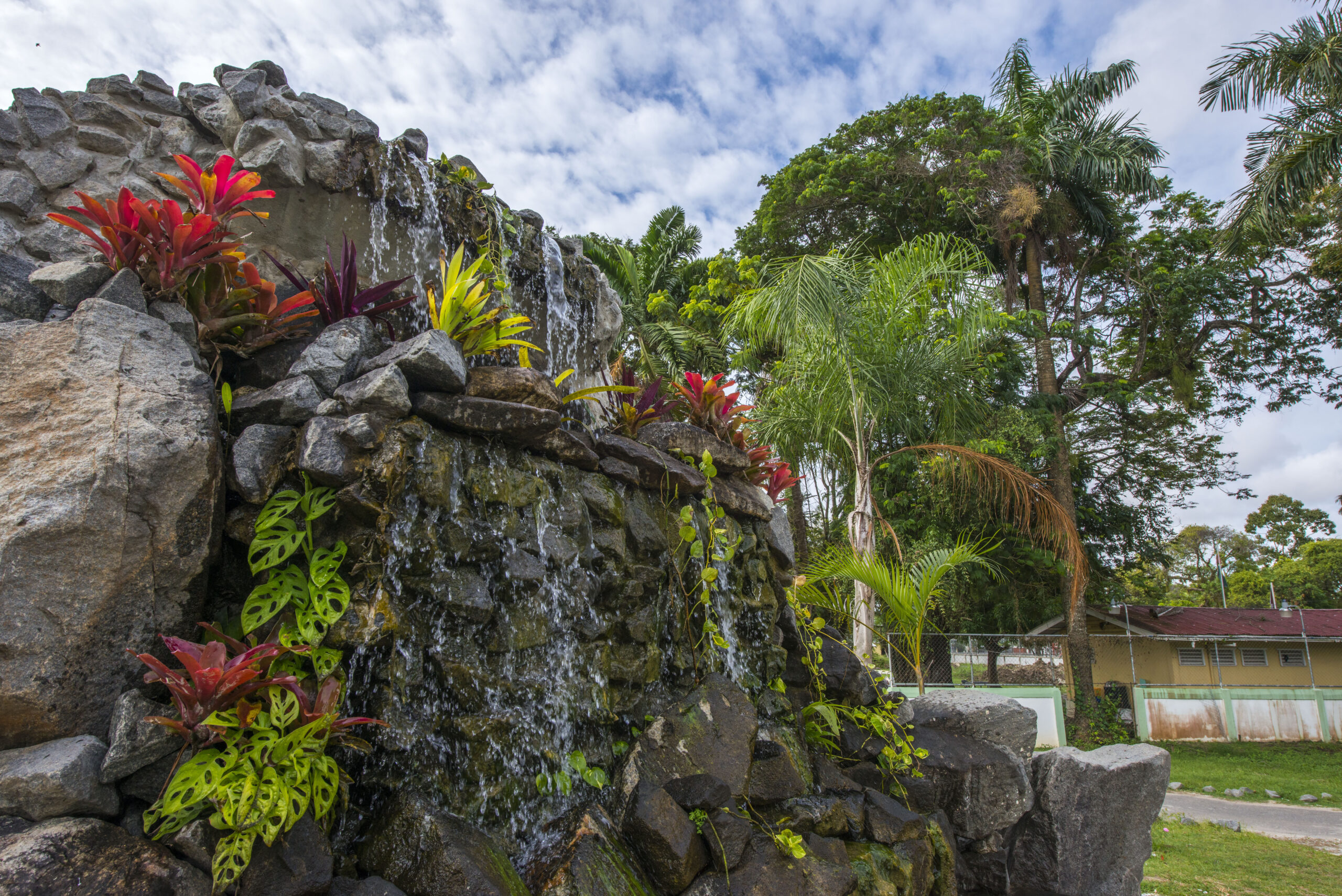
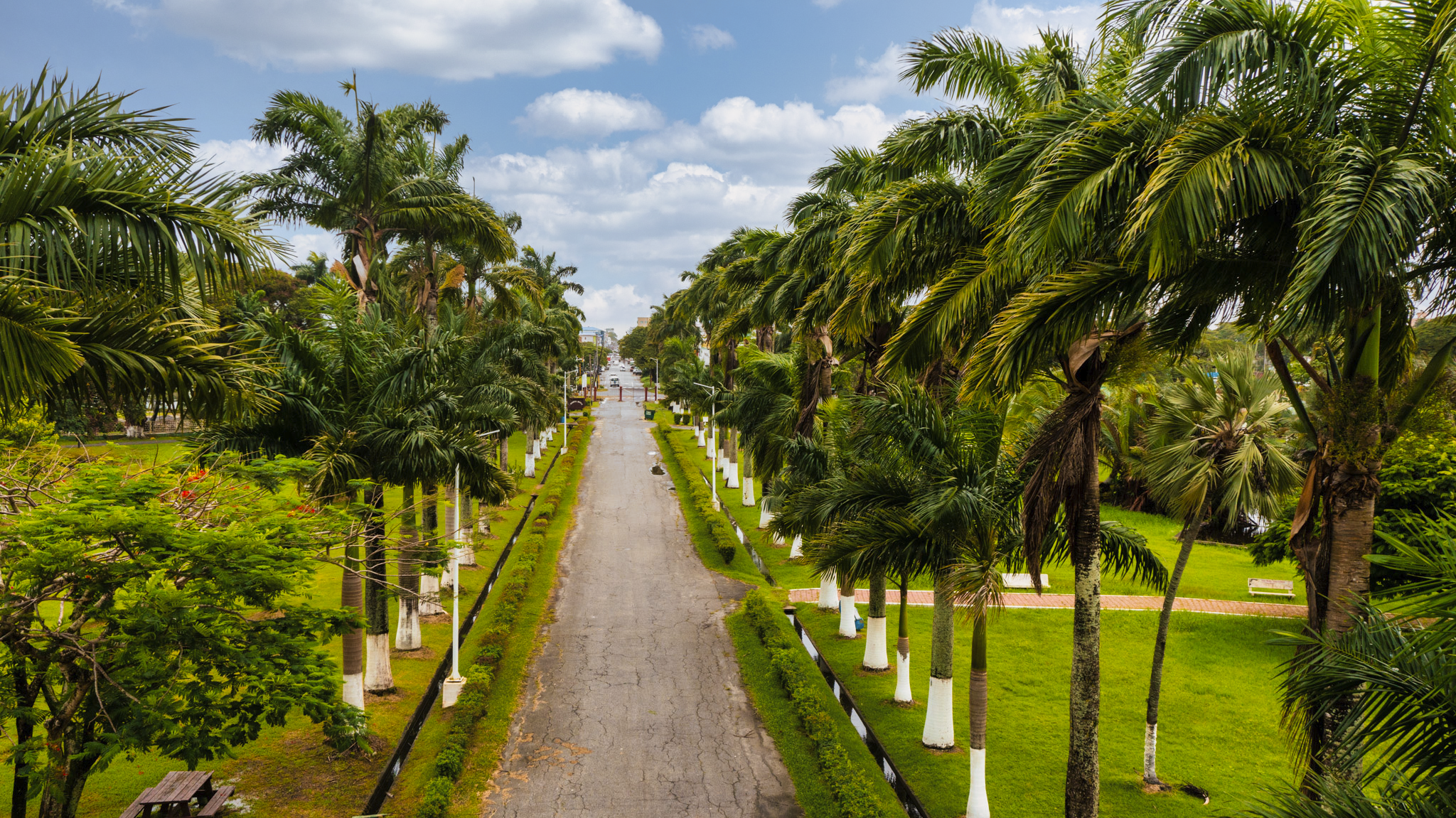
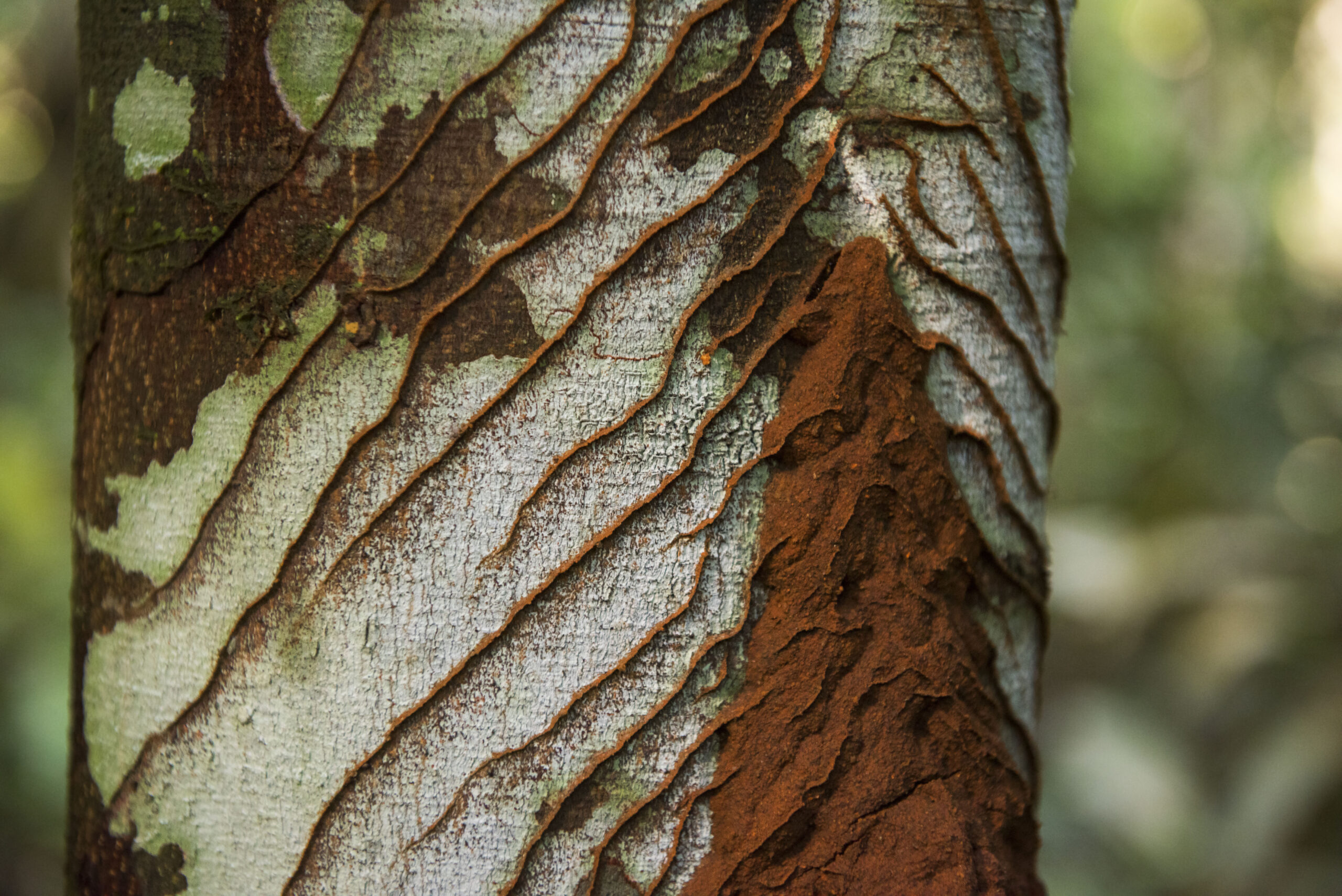
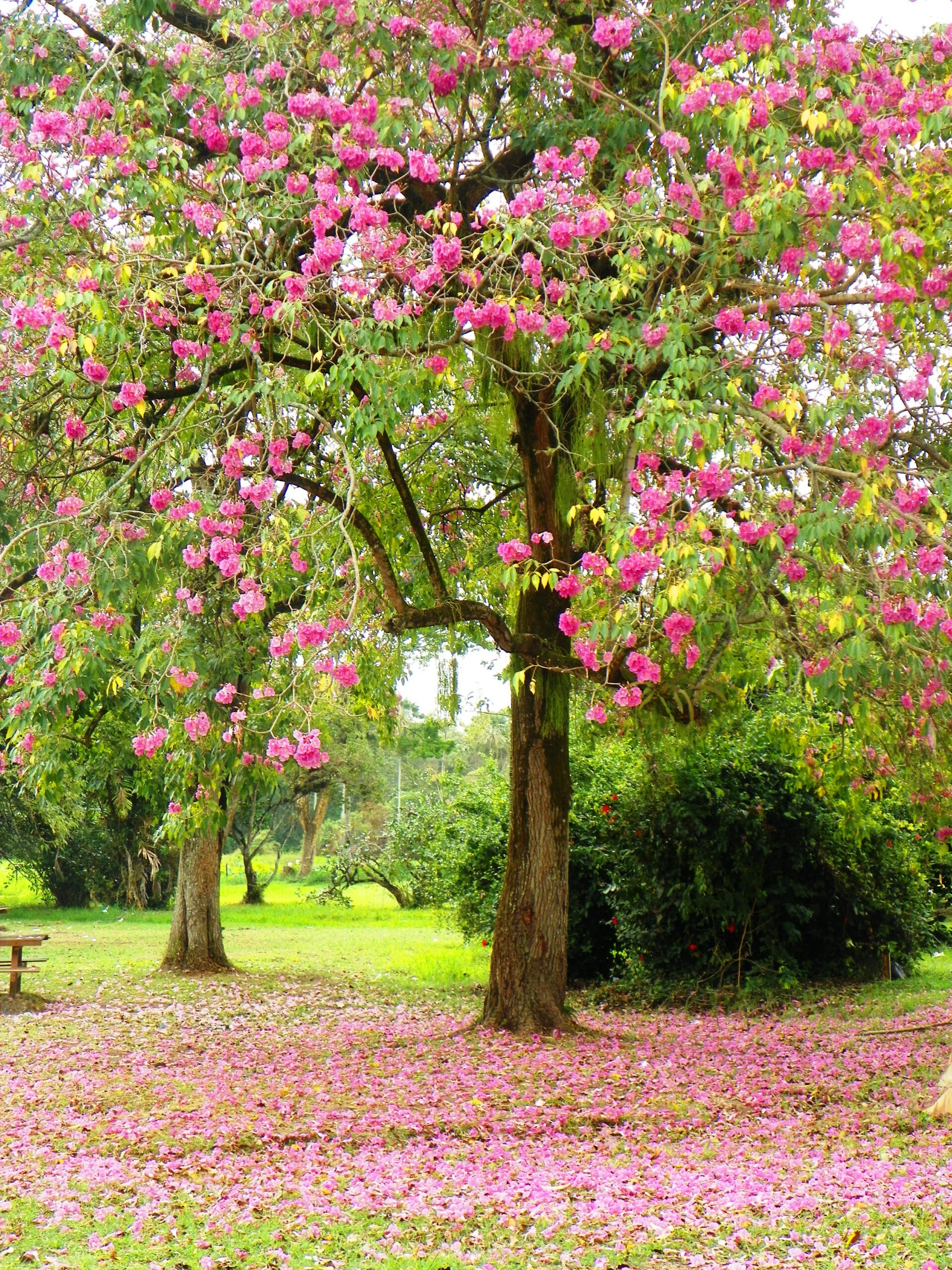
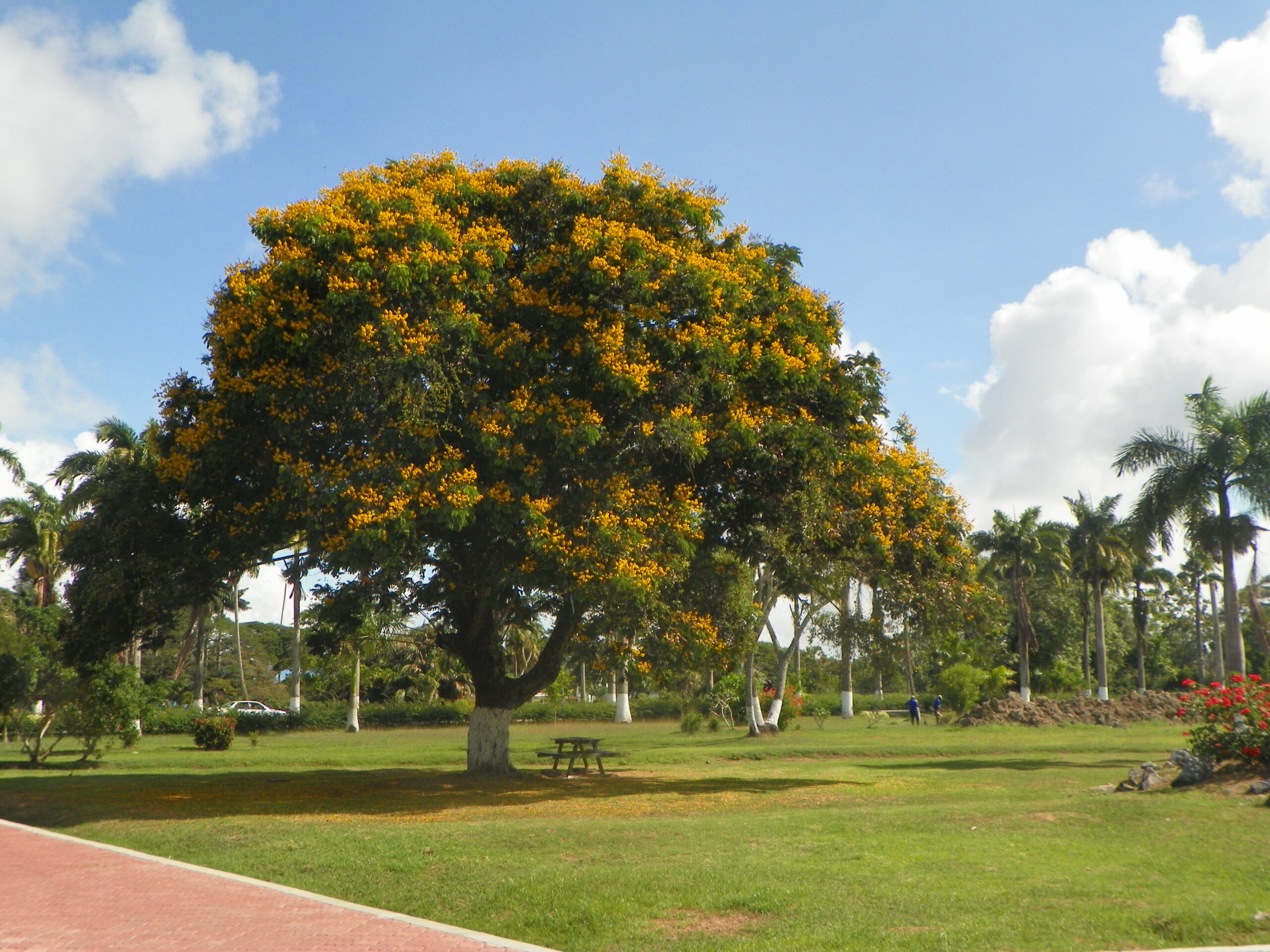
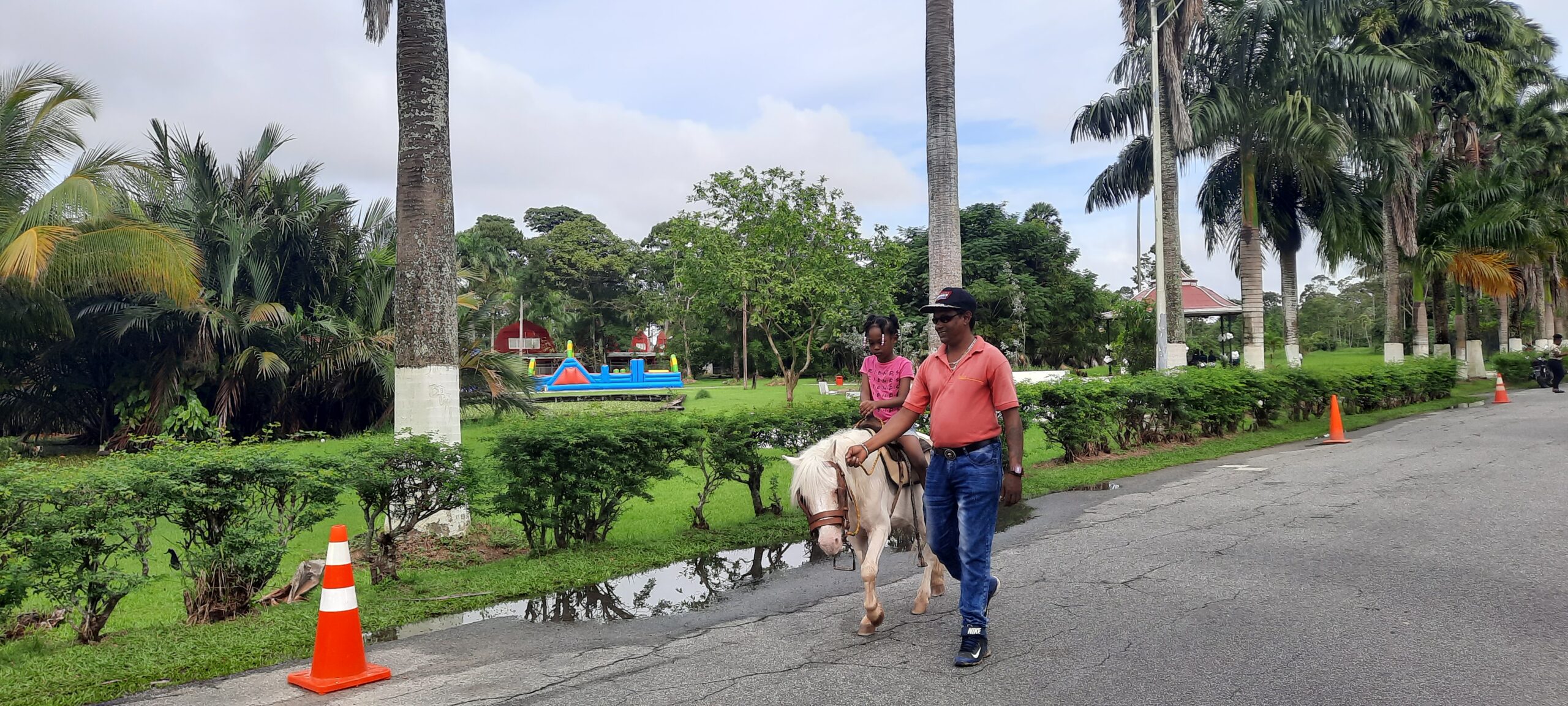
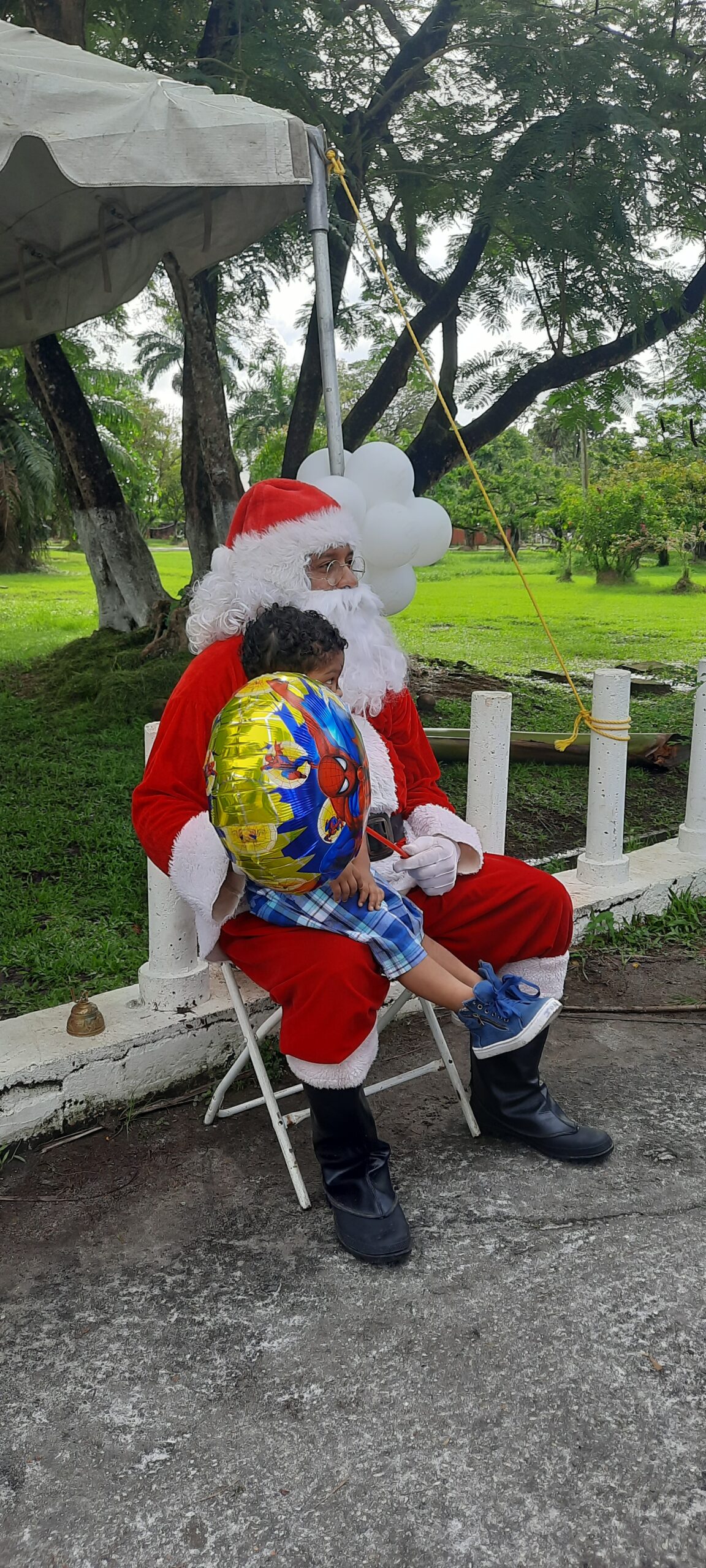
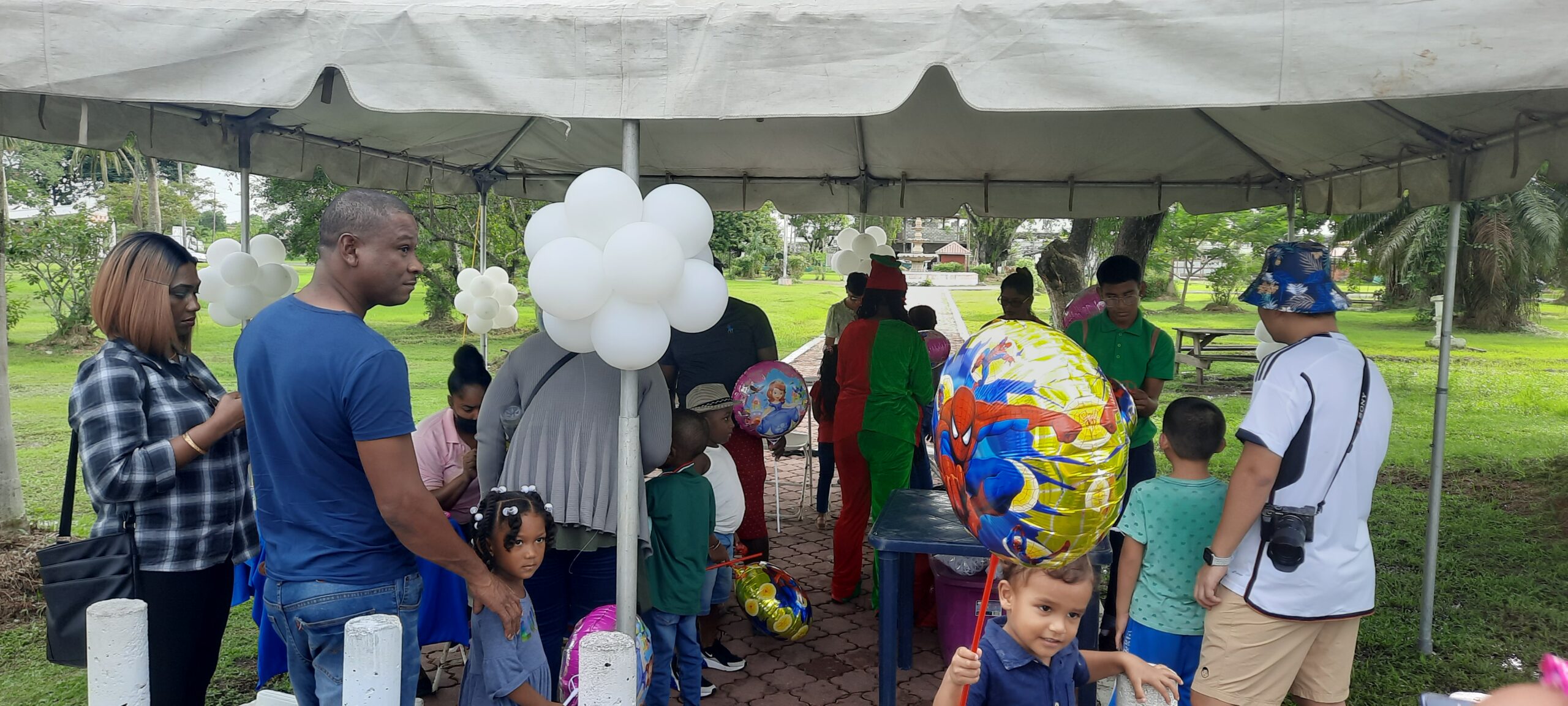
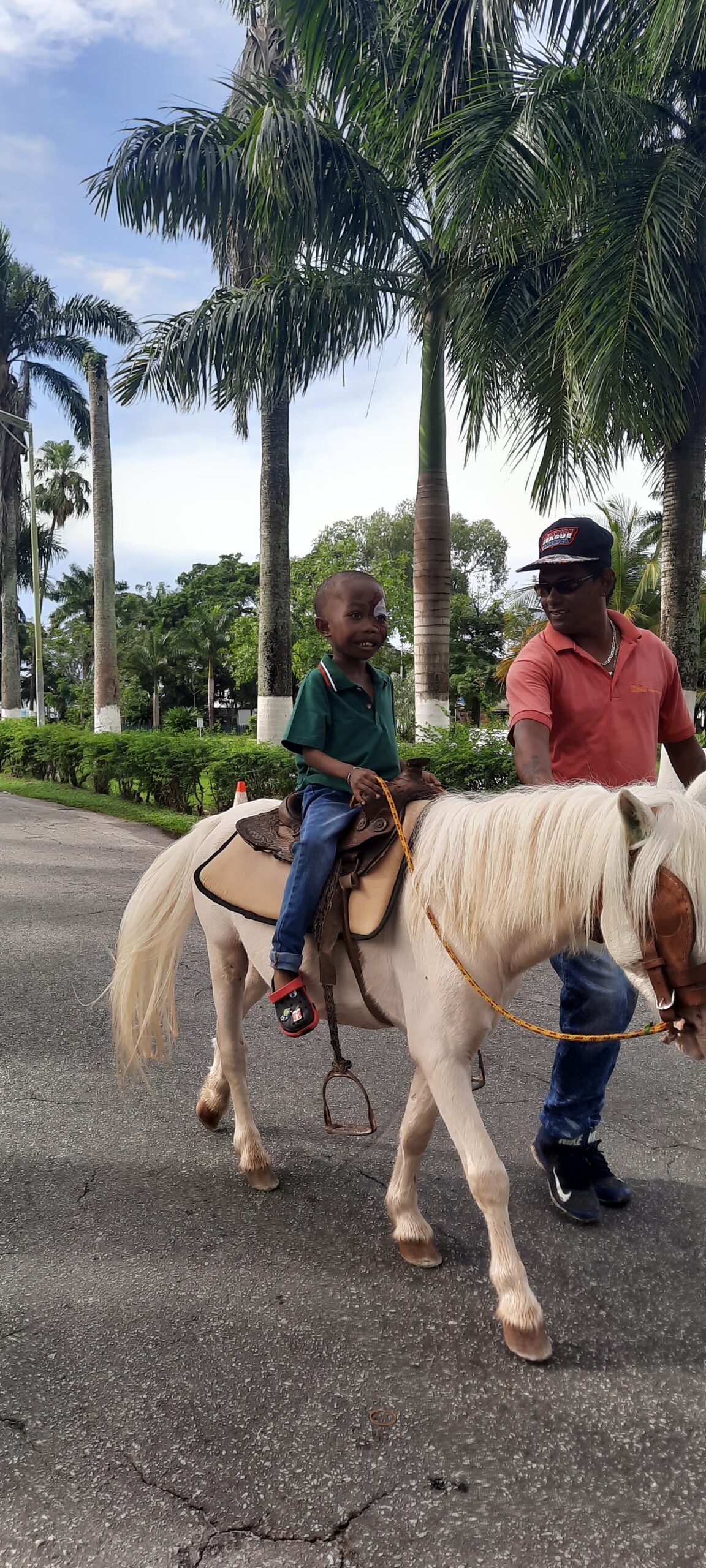
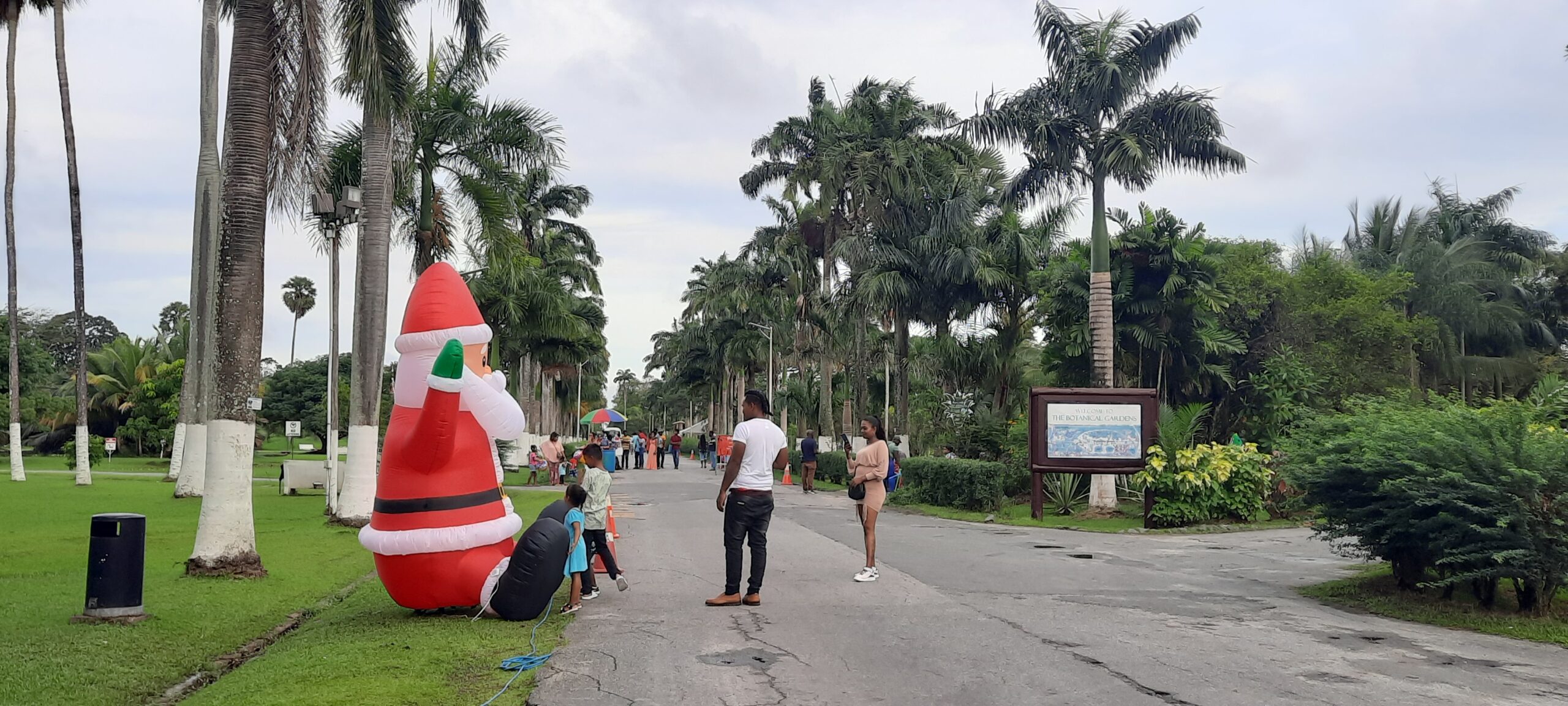
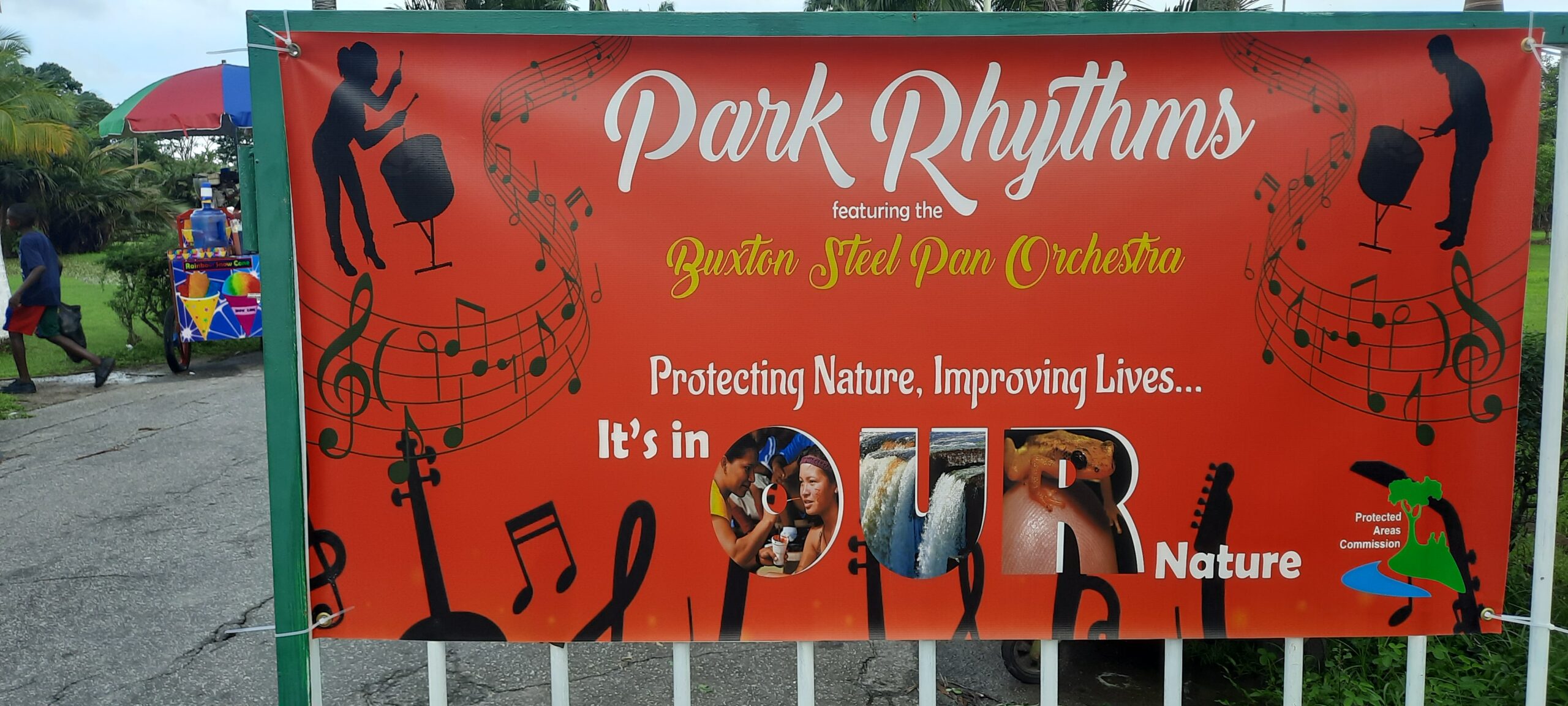
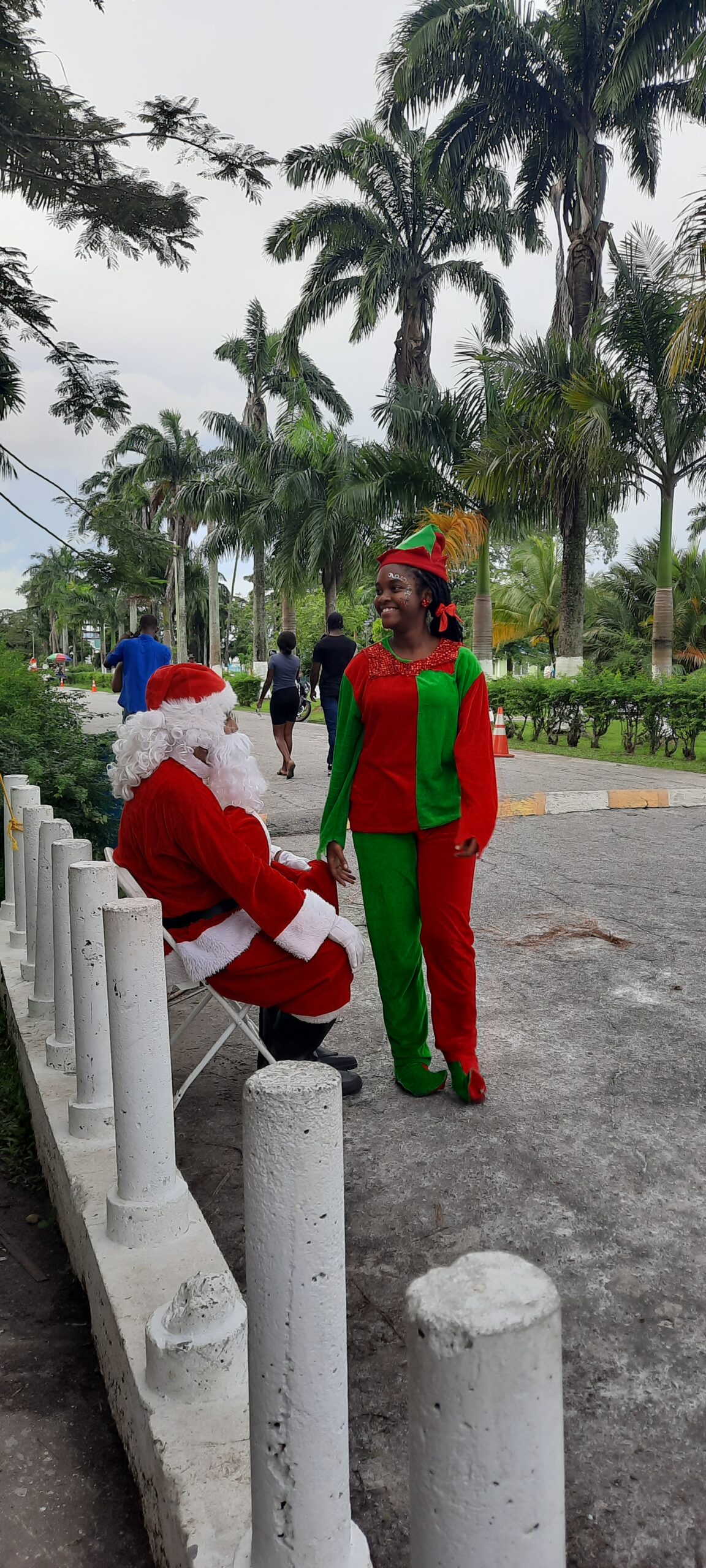
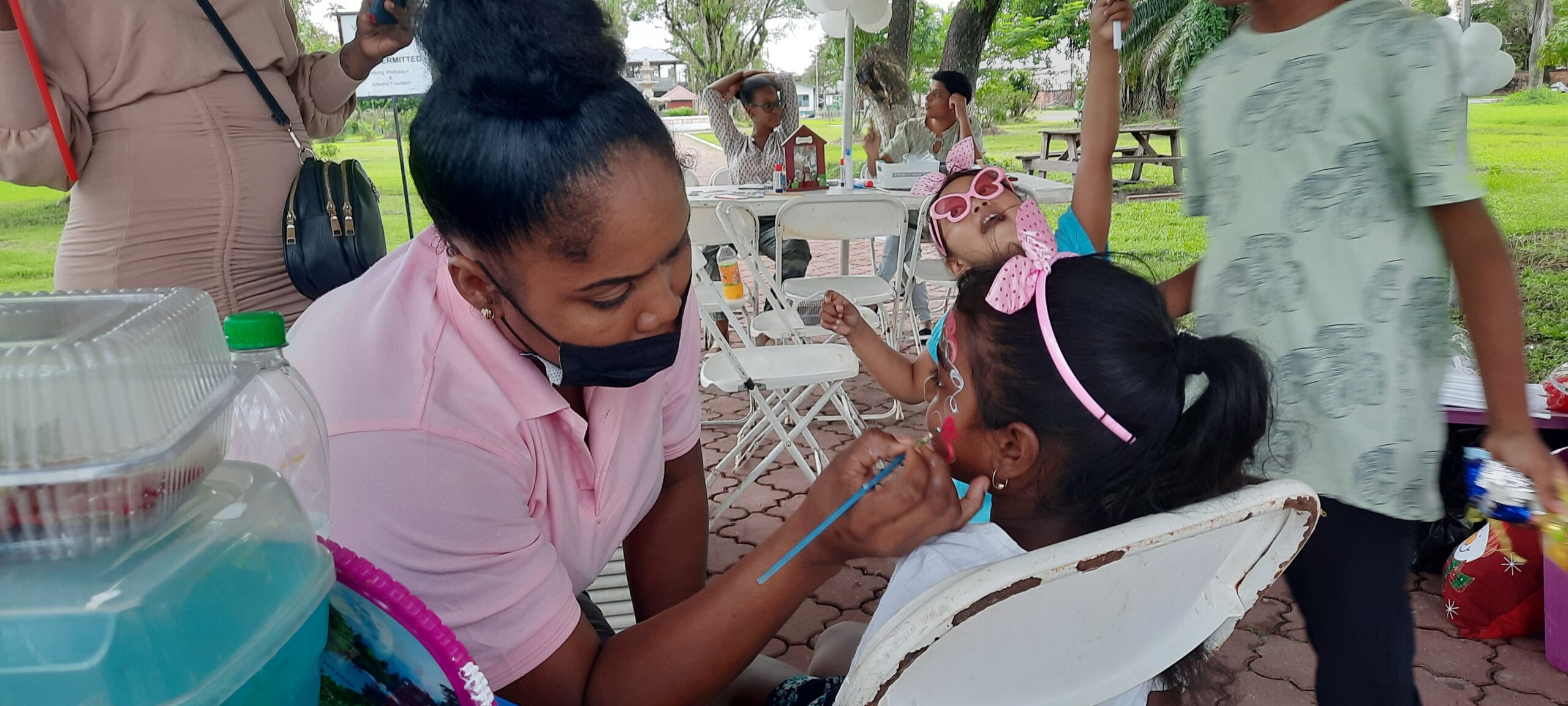
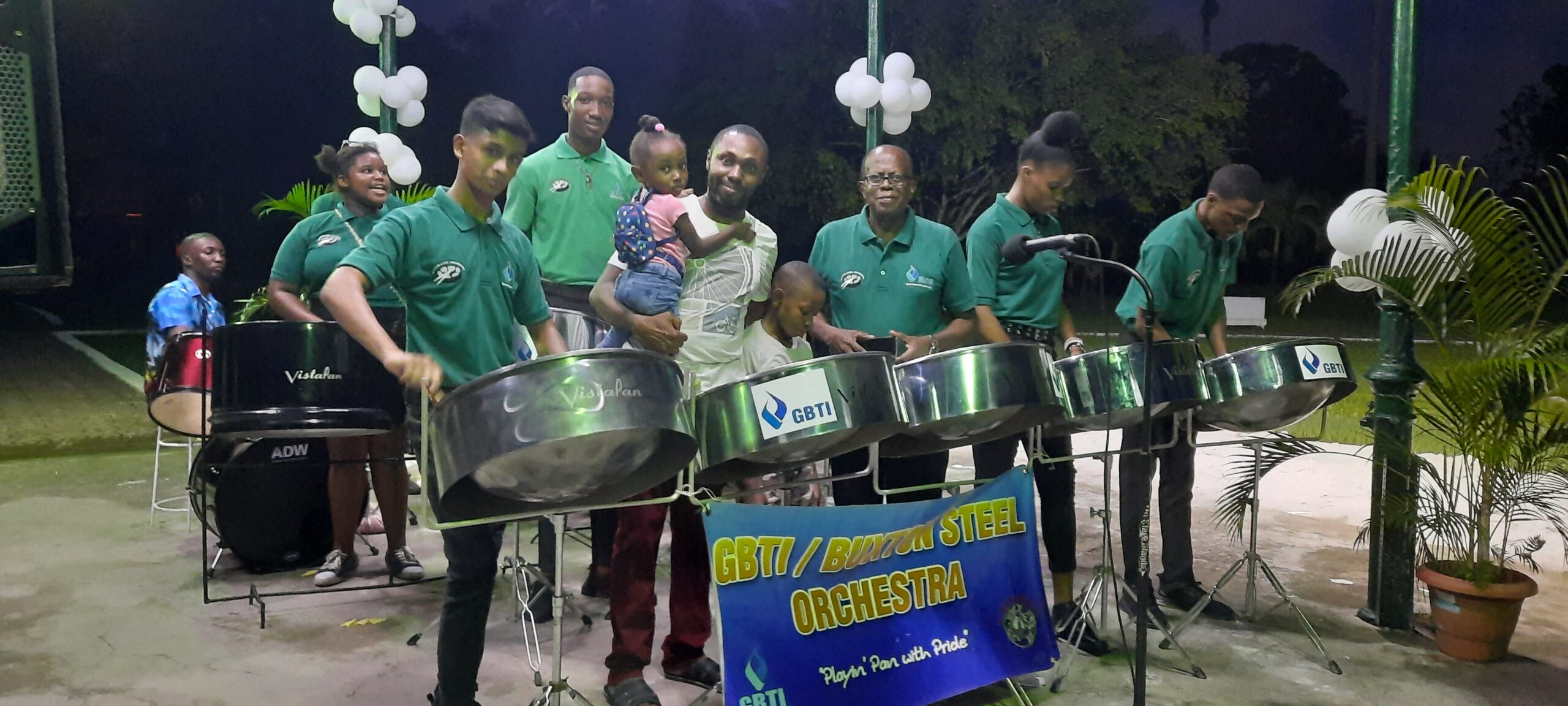
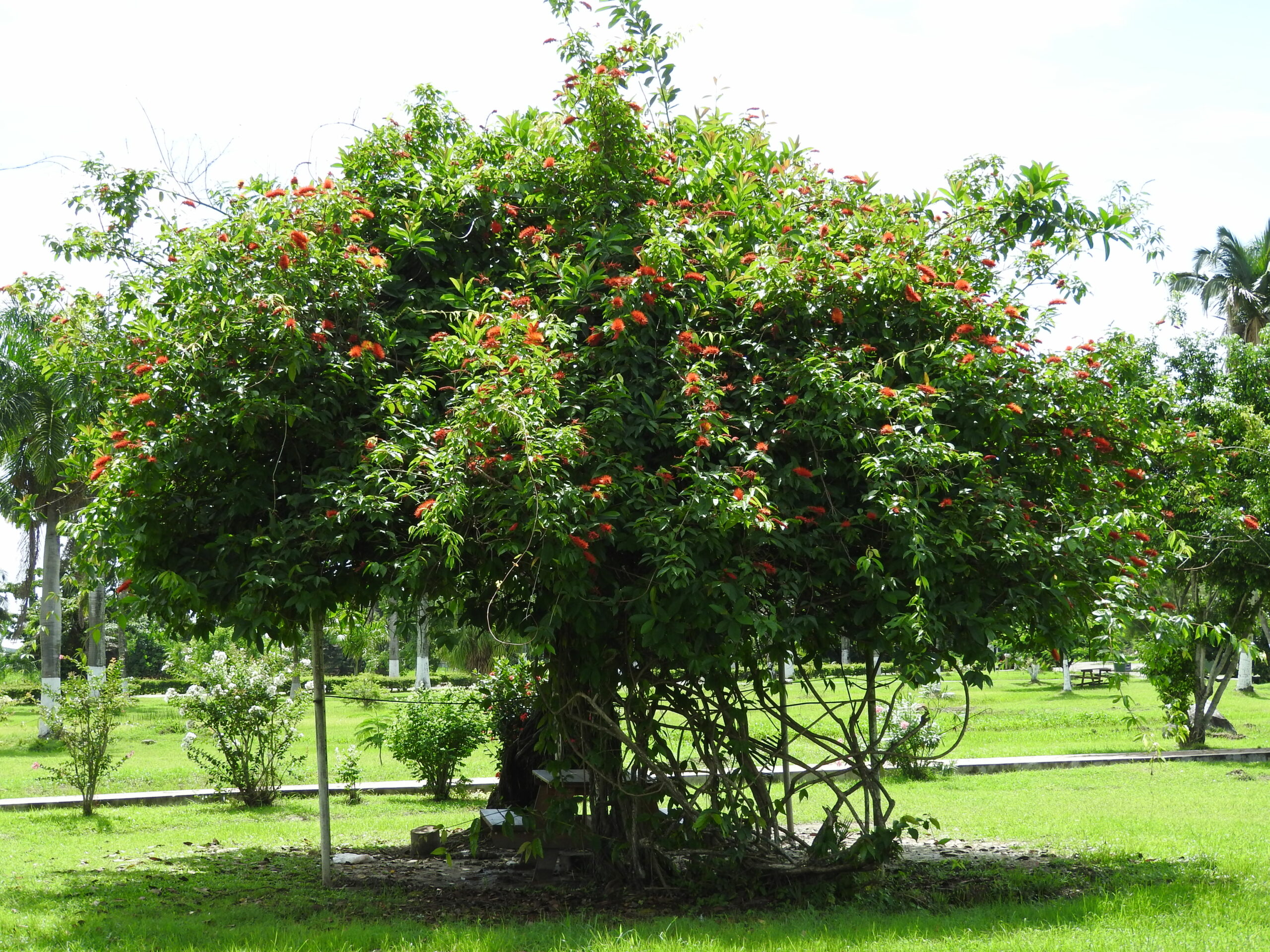
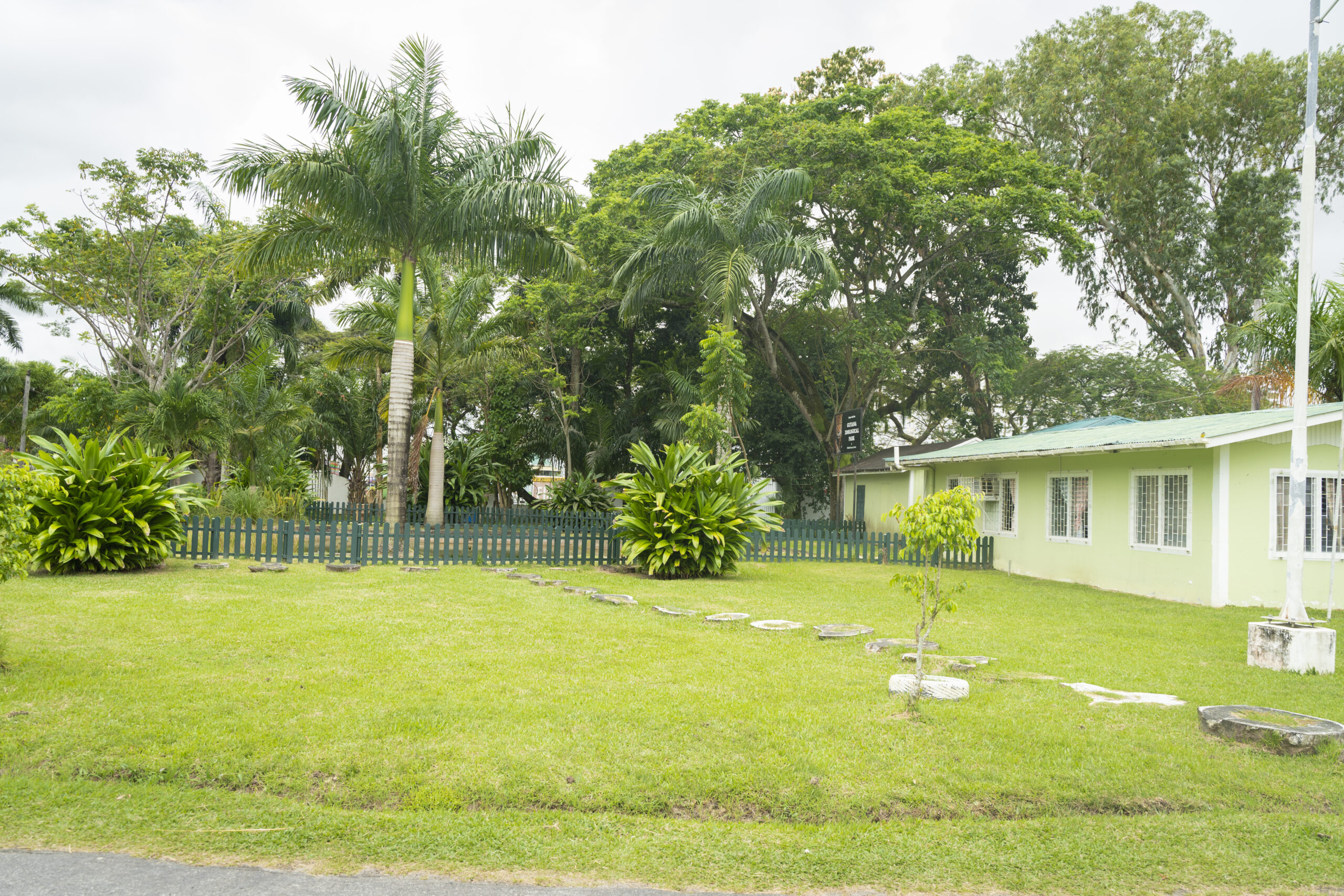
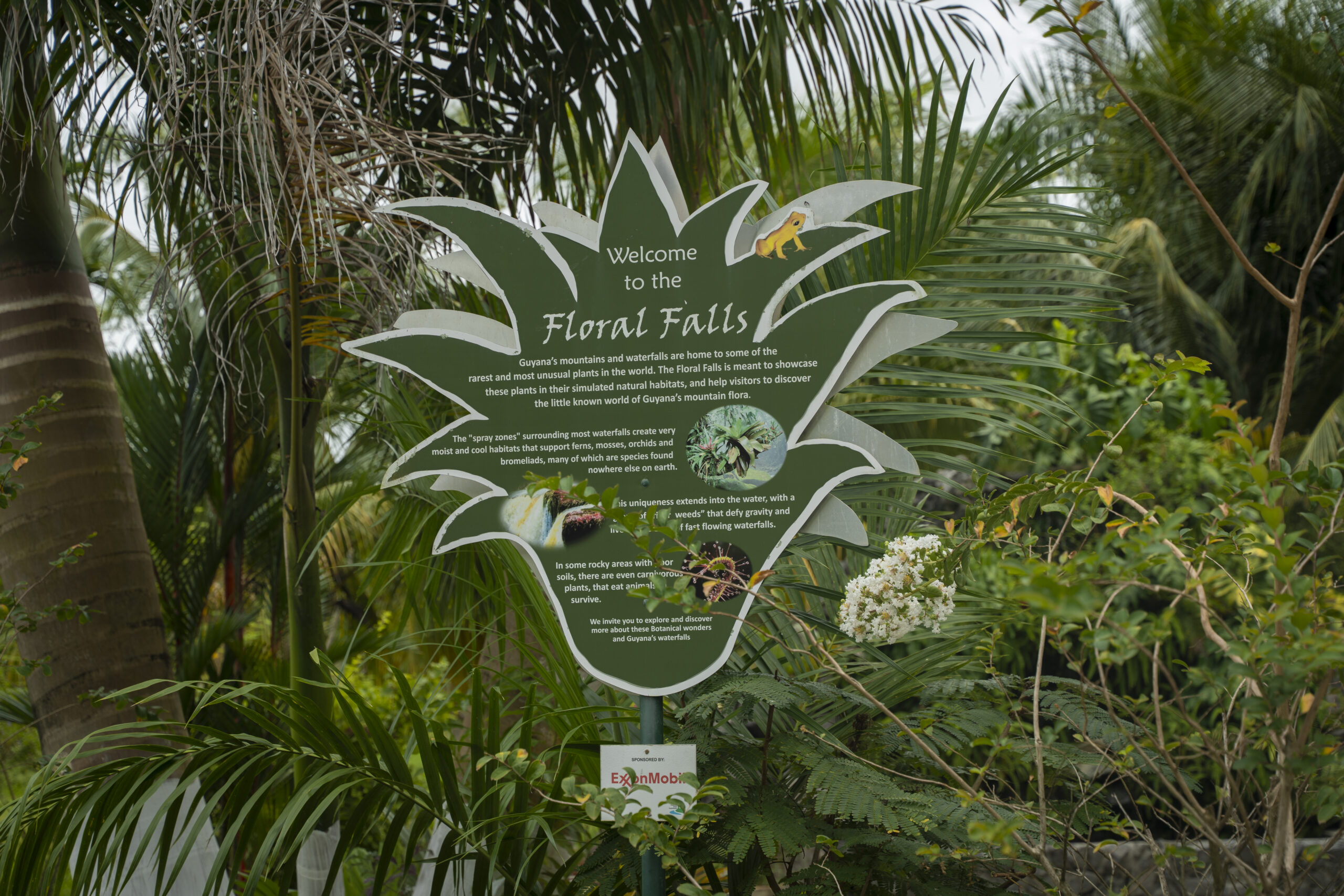
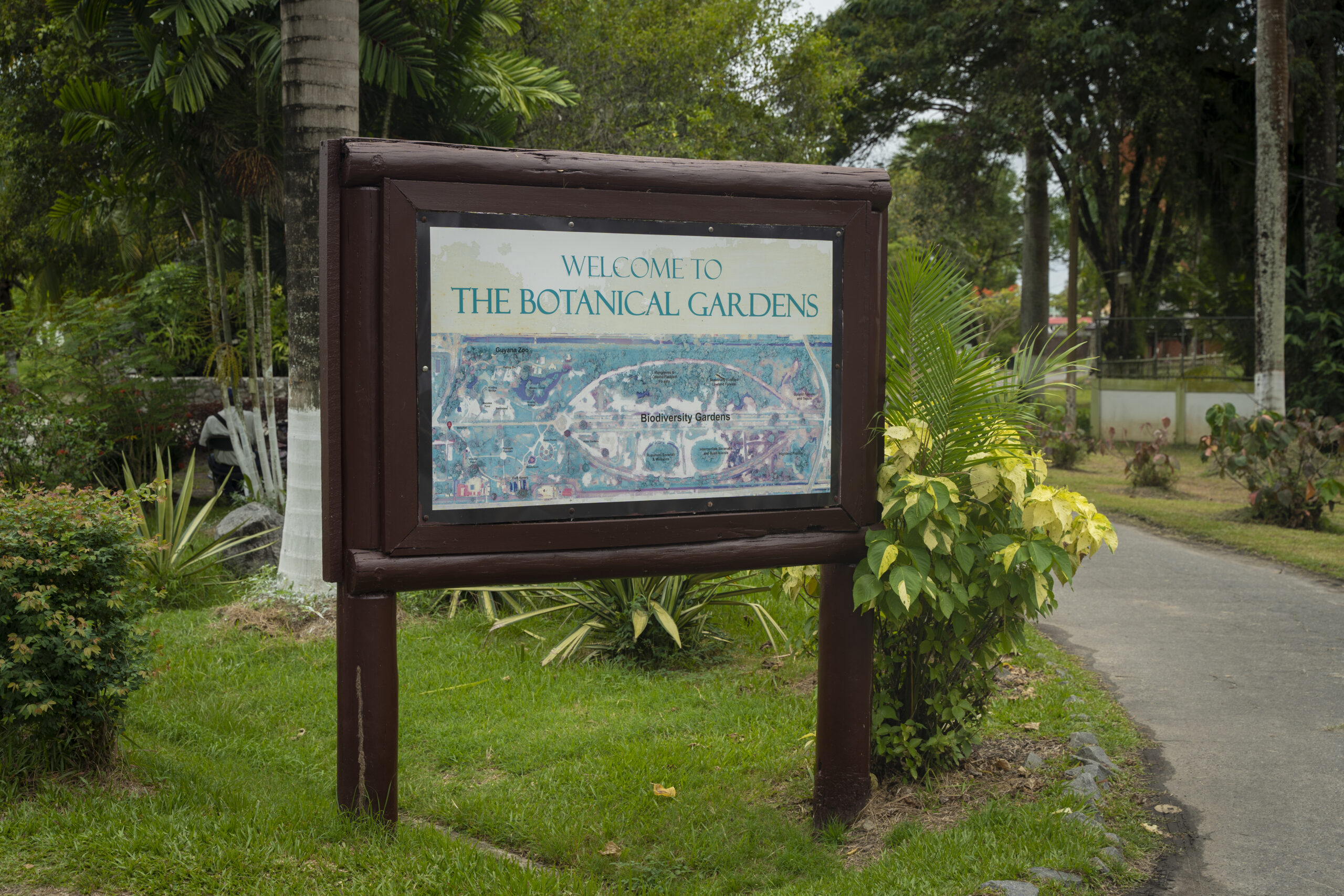
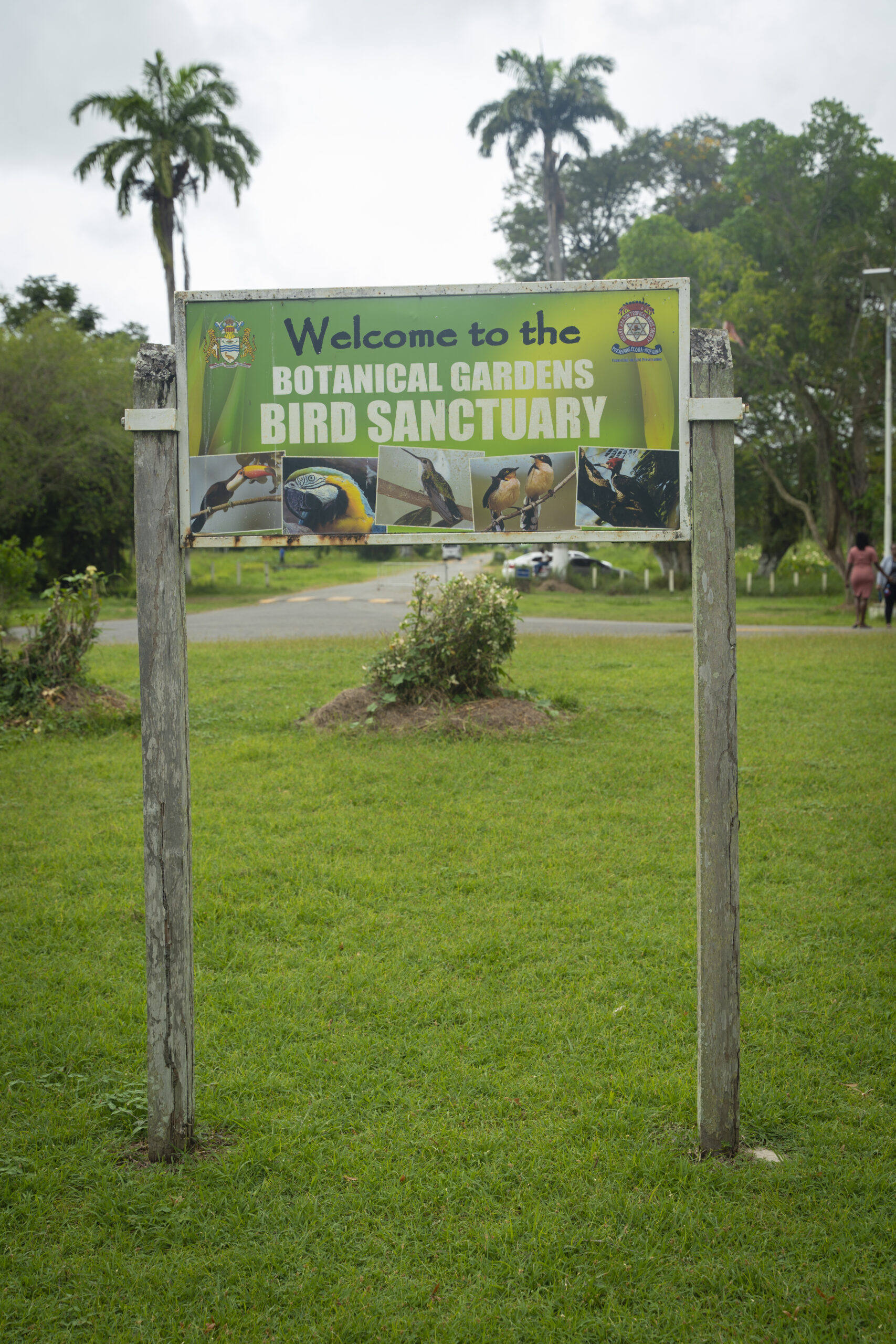
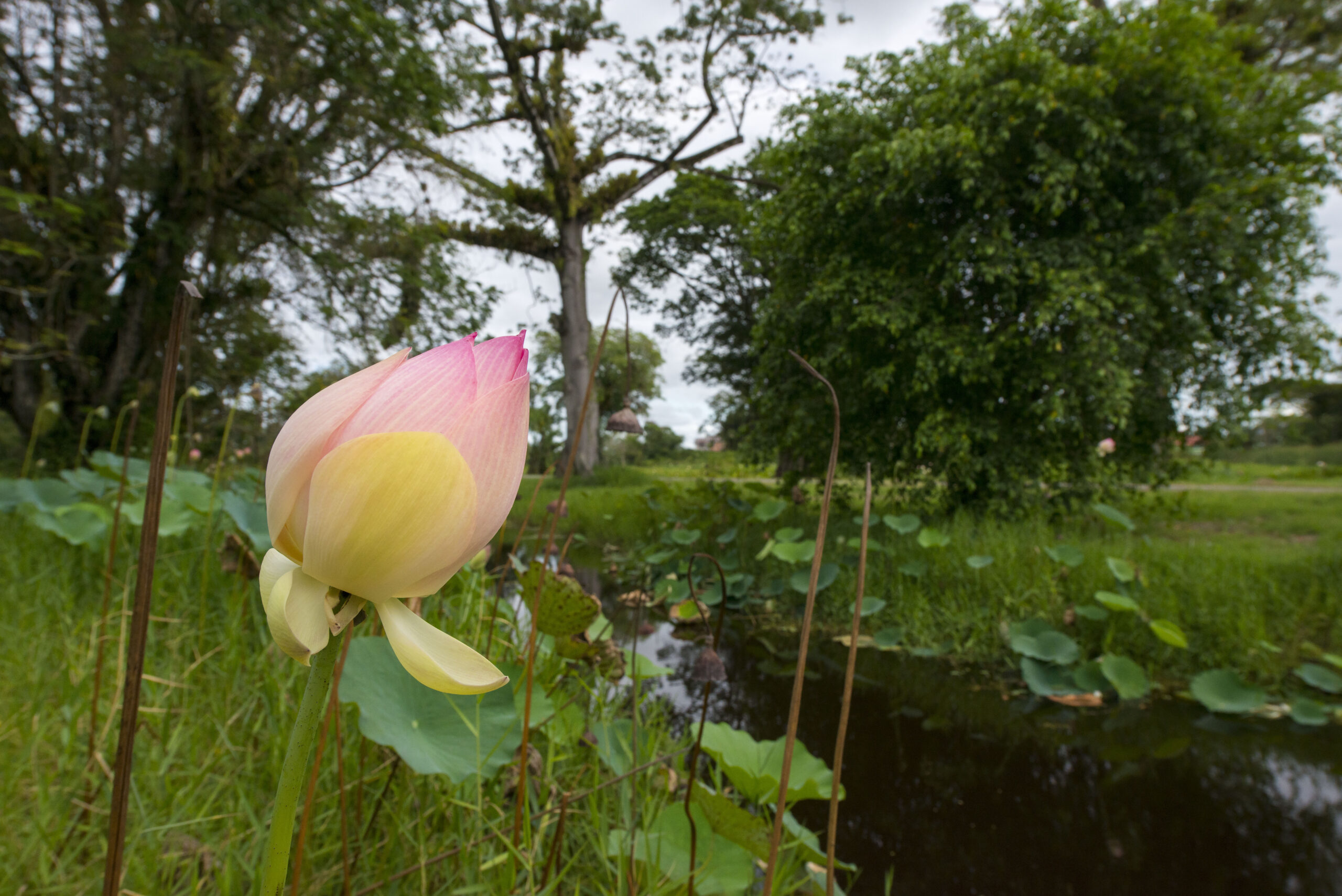
Location: National Park, Thomas Lands, Georgetown, Guyana.
Phone: + 592 227 2265 + 592 226 2323
Email: info@pac.gov.gy
Monday – Thursday 8 am – 4:30 pm
Friday 8 am – 3:30 pm
Saturday – Sunday – Closed
Protected Areas
- Office of the President
- Protected Areas Trust (Guyana)
- Environmental Protection Agency
- Guyana Wildlife Conservation and Management Commission
- Guyana Geology and Mines Commission
- Guyana Lands and Survey Commission
- Ministry of Natural Resources
- Ministry of Amerindian Affairs
- Ministry of Tourism, Industry and Commerce
- Guyana Tourism Authority
- Iwokrama International Centre
- Low Carbon Development Strategy
Newsletter
[mc4wp_form id=”240″]
